A Comprehensive Review: Extra-Curricular Activities in Indian Schools
VerifiedAdded on 2023/06/15
|18
|6363
|198
Literature Review
AI Summary
This literature review examines the role of extra-curricular activities within the Indian education system, highlighting their potential benefits for holistic student development alongside academic achievement. The review discusses the historical context of education in India, transitioning from the ancient Gurukul system that emphasized comprehensive development to the modern system that often prioritizes academic qualifications. It addresses the challenges and obstacles hindering the implementation of robust extra-curricular programs, such as resource constraints, space limitations, and societal pressures that prioritize academic success. Furthermore, the review explores the potential of school-based extra-curricular programs to enhance student outcomes, foster creativity, improve physical and mental health, and provide productive breaks from academic studies. It also touches upon the need for policy changes and government support to ensure the effective integration of extra-curricular activities into the Indian education system, ultimately aiming for a balanced approach that nurtures both academic excellence and diverse talents among students. The document is available on Desklib, a platform offering a wide array of study resources for students.

1
RESEARCH
RESEARCH
Secure Best Marks with AI Grader
Need help grading? Try our AI Grader for instant feedback on your assignments.
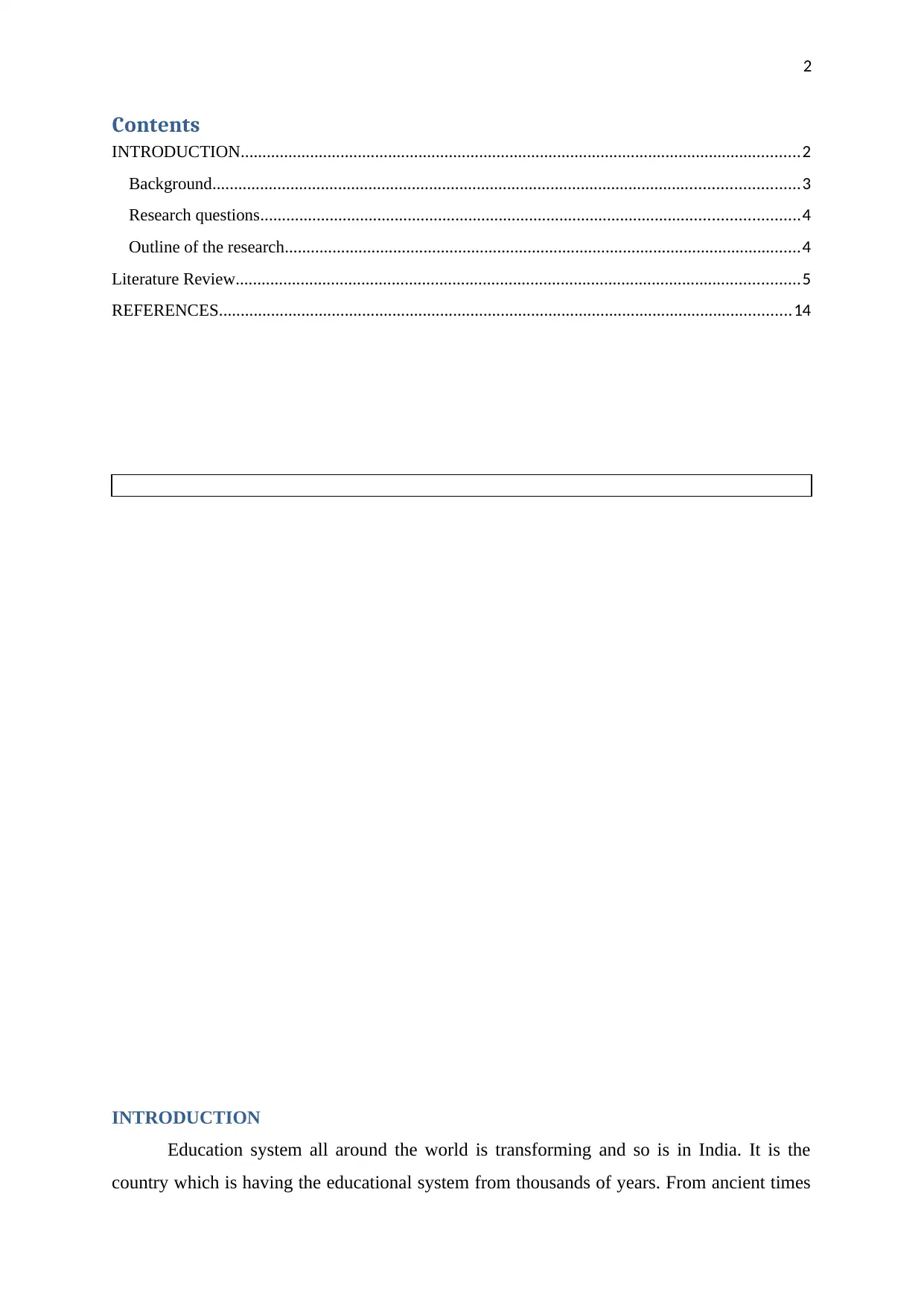
2
Contents
INTRODUCTION.................................................................................................................................2
Background.......................................................................................................................................3
Research questions............................................................................................................................4
Outline of the research.......................................................................................................................4
Literature Review..................................................................................................................................5
REFERENCES....................................................................................................................................14
INTRODUCTION
Education system all around the world is transforming and so is in India. It is the
country which is having the educational system from thousands of years. From ancient times
Contents
INTRODUCTION.................................................................................................................................2
Background.......................................................................................................................................3
Research questions............................................................................................................................4
Outline of the research.......................................................................................................................4
Literature Review..................................................................................................................................5
REFERENCES....................................................................................................................................14
INTRODUCTION
Education system all around the world is transforming and so is in India. It is the
country which is having the educational system from thousands of years. From ancient times
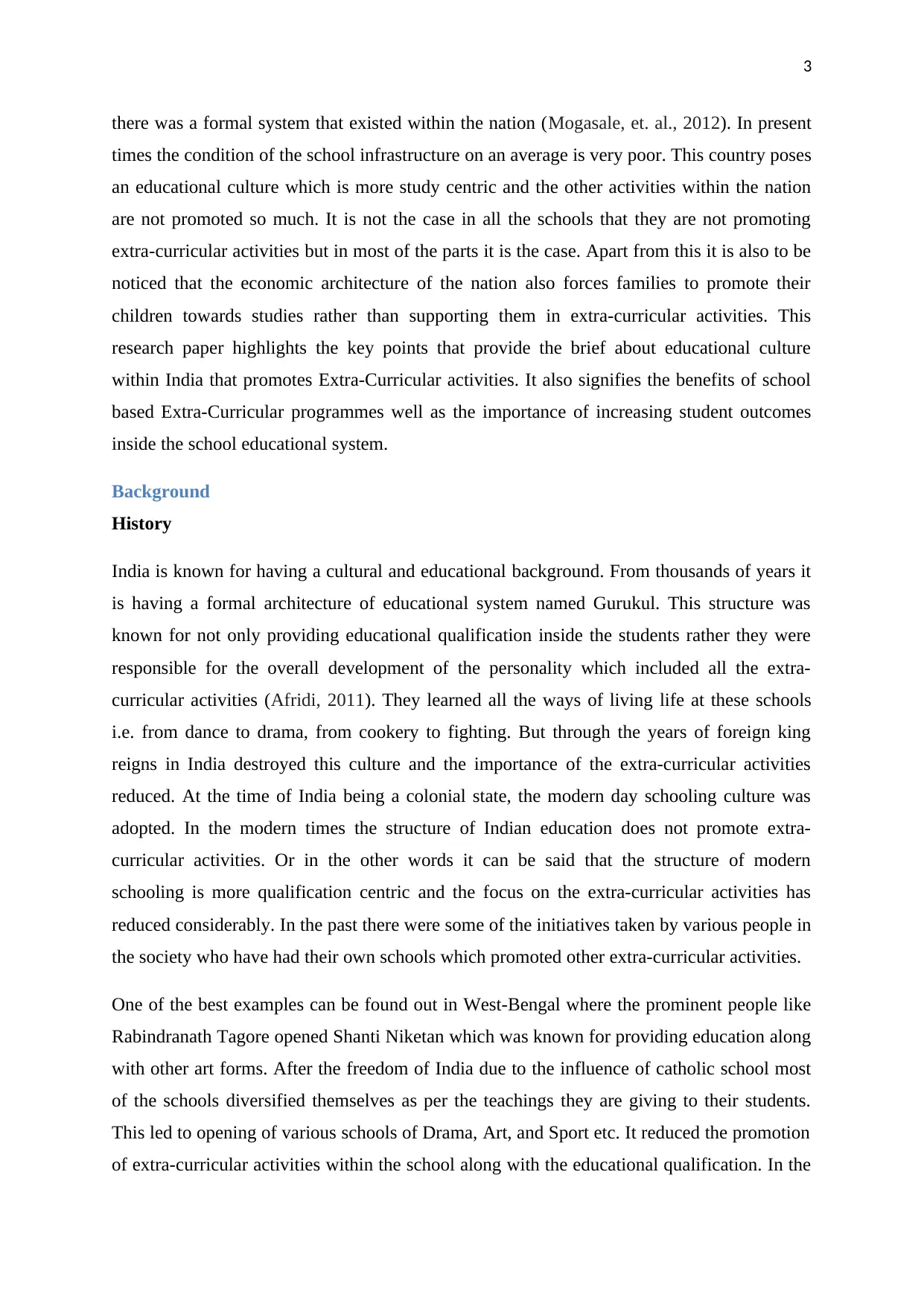
3
there was a formal system that existed within the nation (Mogasale, et. al., 2012). In present
times the condition of the school infrastructure on an average is very poor. This country poses
an educational culture which is more study centric and the other activities within the nation
are not promoted so much. It is not the case in all the schools that they are not promoting
extra-curricular activities but in most of the parts it is the case. Apart from this it is also to be
noticed that the economic architecture of the nation also forces families to promote their
children towards studies rather than supporting them in extra-curricular activities. This
research paper highlights the key points that provide the brief about educational culture
within India that promotes Extra-Curricular activities. It also signifies the benefits of school
based Extra-Curricular programmes well as the importance of increasing student outcomes
inside the school educational system.
Background
History
India is known for having a cultural and educational background. From thousands of years it
is having a formal architecture of educational system named Gurukul. This structure was
known for not only providing educational qualification inside the students rather they were
responsible for the overall development of the personality which included all the extra-
curricular activities (Afridi, 2011). They learned all the ways of living life at these schools
i.e. from dance to drama, from cookery to fighting. But through the years of foreign king
reigns in India destroyed this culture and the importance of the extra-curricular activities
reduced. At the time of India being a colonial state, the modern day schooling culture was
adopted. In the modern times the structure of Indian education does not promote extra-
curricular activities. Or in the other words it can be said that the structure of modern
schooling is more qualification centric and the focus on the extra-curricular activities has
reduced considerably. In the past there were some of the initiatives taken by various people in
the society who have had their own schools which promoted other extra-curricular activities.
One of the best examples can be found out in West-Bengal where the prominent people like
Rabindranath Tagore opened Shanti Niketan which was known for providing education along
with other art forms. After the freedom of India due to the influence of catholic school most
of the schools diversified themselves as per the teachings they are giving to their students.
This led to opening of various schools of Drama, Art, and Sport etc. It reduced the promotion
of extra-curricular activities within the school along with the educational qualification. In the
there was a formal system that existed within the nation (Mogasale, et. al., 2012). In present
times the condition of the school infrastructure on an average is very poor. This country poses
an educational culture which is more study centric and the other activities within the nation
are not promoted so much. It is not the case in all the schools that they are not promoting
extra-curricular activities but in most of the parts it is the case. Apart from this it is also to be
noticed that the economic architecture of the nation also forces families to promote their
children towards studies rather than supporting them in extra-curricular activities. This
research paper highlights the key points that provide the brief about educational culture
within India that promotes Extra-Curricular activities. It also signifies the benefits of school
based Extra-Curricular programmes well as the importance of increasing student outcomes
inside the school educational system.
Background
History
India is known for having a cultural and educational background. From thousands of years it
is having a formal architecture of educational system named Gurukul. This structure was
known for not only providing educational qualification inside the students rather they were
responsible for the overall development of the personality which included all the extra-
curricular activities (Afridi, 2011). They learned all the ways of living life at these schools
i.e. from dance to drama, from cookery to fighting. But through the years of foreign king
reigns in India destroyed this culture and the importance of the extra-curricular activities
reduced. At the time of India being a colonial state, the modern day schooling culture was
adopted. In the modern times the structure of Indian education does not promote extra-
curricular activities. Or in the other words it can be said that the structure of modern
schooling is more qualification centric and the focus on the extra-curricular activities has
reduced considerably. In the past there were some of the initiatives taken by various people in
the society who have had their own schools which promoted other extra-curricular activities.
One of the best examples can be found out in West-Bengal where the prominent people like
Rabindranath Tagore opened Shanti Niketan which was known for providing education along
with other art forms. After the freedom of India due to the influence of catholic school most
of the schools diversified themselves as per the teachings they are giving to their students.
This led to opening of various schools of Drama, Art, and Sport etc. It reduced the promotion
of extra-curricular activities within the school along with the educational qualification. In the
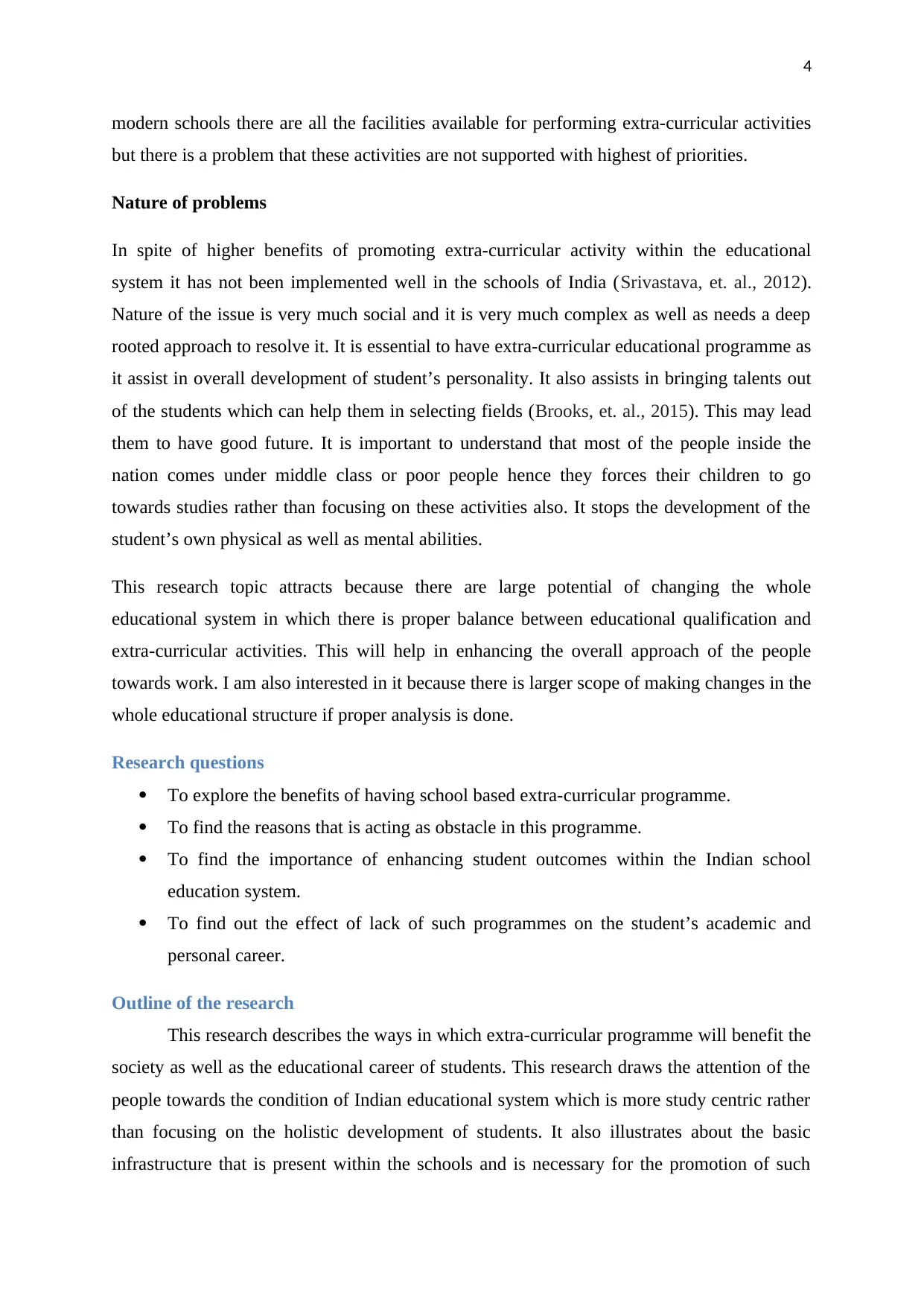
4
modern schools there are all the facilities available for performing extra-curricular activities
but there is a problem that these activities are not supported with highest of priorities.
Nature of problems
In spite of higher benefits of promoting extra-curricular activity within the educational
system it has not been implemented well in the schools of India (Srivastava, et. al., 2012).
Nature of the issue is very much social and it is very much complex as well as needs a deep
rooted approach to resolve it. It is essential to have extra-curricular educational programme as
it assist in overall development of student’s personality. It also assists in bringing talents out
of the students which can help them in selecting fields (Brooks, et. al., 2015). This may lead
them to have good future. It is important to understand that most of the people inside the
nation comes under middle class or poor people hence they forces their children to go
towards studies rather than focusing on these activities also. It stops the development of the
student’s own physical as well as mental abilities.
This research topic attracts because there are large potential of changing the whole
educational system in which there is proper balance between educational qualification and
extra-curricular activities. This will help in enhancing the overall approach of the people
towards work. I am also interested in it because there is larger scope of making changes in the
whole educational structure if proper analysis is done.
Research questions
To explore the benefits of having school based extra-curricular programme.
To find the reasons that is acting as obstacle in this programme.
To find the importance of enhancing student outcomes within the Indian school
education system.
To find out the effect of lack of such programmes on the student’s academic and
personal career.
Outline of the research
This research describes the ways in which extra-curricular programme will benefit the
society as well as the educational career of students. This research draws the attention of the
people towards the condition of Indian educational system which is more study centric rather
than focusing on the holistic development of students. It also illustrates about the basic
infrastructure that is present within the schools and is necessary for the promotion of such
modern schools there are all the facilities available for performing extra-curricular activities
but there is a problem that these activities are not supported with highest of priorities.
Nature of problems
In spite of higher benefits of promoting extra-curricular activity within the educational
system it has not been implemented well in the schools of India (Srivastava, et. al., 2012).
Nature of the issue is very much social and it is very much complex as well as needs a deep
rooted approach to resolve it. It is essential to have extra-curricular educational programme as
it assist in overall development of student’s personality. It also assists in bringing talents out
of the students which can help them in selecting fields (Brooks, et. al., 2015). This may lead
them to have good future. It is important to understand that most of the people inside the
nation comes under middle class or poor people hence they forces their children to go
towards studies rather than focusing on these activities also. It stops the development of the
student’s own physical as well as mental abilities.
This research topic attracts because there are large potential of changing the whole
educational system in which there is proper balance between educational qualification and
extra-curricular activities. This will help in enhancing the overall approach of the people
towards work. I am also interested in it because there is larger scope of making changes in the
whole educational structure if proper analysis is done.
Research questions
To explore the benefits of having school based extra-curricular programme.
To find the reasons that is acting as obstacle in this programme.
To find the importance of enhancing student outcomes within the Indian school
education system.
To find out the effect of lack of such programmes on the student’s academic and
personal career.
Outline of the research
This research describes the ways in which extra-curricular programme will benefit the
society as well as the educational career of students. This research draws the attention of the
people towards the condition of Indian educational system which is more study centric rather
than focusing on the holistic development of students. It also illustrates about the basic
infrastructure that is present within the schools and is necessary for the promotion of such
Secure Best Marks with AI Grader
Need help grading? Try our AI Grader for instant feedback on your assignments.
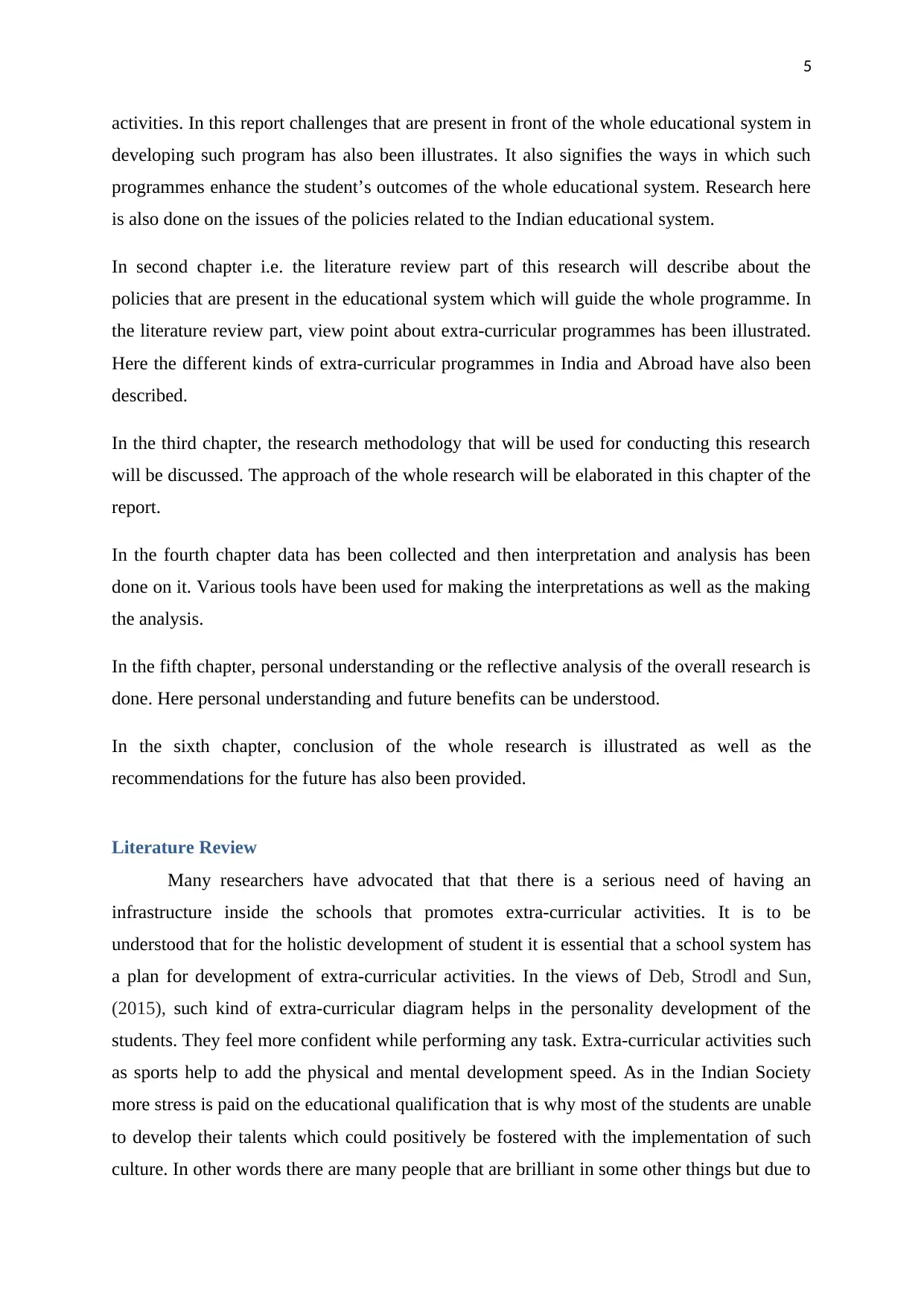
5
activities. In this report challenges that are present in front of the whole educational system in
developing such program has also been illustrates. It also signifies the ways in which such
programmes enhance the student’s outcomes of the whole educational system. Research here
is also done on the issues of the policies related to the Indian educational system.
In second chapter i.e. the literature review part of this research will describe about the
policies that are present in the educational system which will guide the whole programme. In
the literature review part, view point about extra-curricular programmes has been illustrated.
Here the different kinds of extra-curricular programmes in India and Abroad have also been
described.
In the third chapter, the research methodology that will be used for conducting this research
will be discussed. The approach of the whole research will be elaborated in this chapter of the
report.
In the fourth chapter data has been collected and then interpretation and analysis has been
done on it. Various tools have been used for making the interpretations as well as the making
the analysis.
In the fifth chapter, personal understanding or the reflective analysis of the overall research is
done. Here personal understanding and future benefits can be understood.
In the sixth chapter, conclusion of the whole research is illustrated as well as the
recommendations for the future has also been provided.
Literature Review
Many researchers have advocated that that there is a serious need of having an
infrastructure inside the schools that promotes extra-curricular activities. It is to be
understood that for the holistic development of student it is essential that a school system has
a plan for development of extra-curricular activities. In the views of Deb, Strodl and Sun,
(2015), such kind of extra-curricular diagram helps in the personality development of the
students. They feel more confident while performing any task. Extra-curricular activities such
as sports help to add the physical and mental development speed. As in the Indian Society
more stress is paid on the educational qualification that is why most of the students are unable
to develop their talents which could positively be fostered with the implementation of such
culture. In other words there are many people that are brilliant in some other things but due to
activities. In this report challenges that are present in front of the whole educational system in
developing such program has also been illustrates. It also signifies the ways in which such
programmes enhance the student’s outcomes of the whole educational system. Research here
is also done on the issues of the policies related to the Indian educational system.
In second chapter i.e. the literature review part of this research will describe about the
policies that are present in the educational system which will guide the whole programme. In
the literature review part, view point about extra-curricular programmes has been illustrated.
Here the different kinds of extra-curricular programmes in India and Abroad have also been
described.
In the third chapter, the research methodology that will be used for conducting this research
will be discussed. The approach of the whole research will be elaborated in this chapter of the
report.
In the fourth chapter data has been collected and then interpretation and analysis has been
done on it. Various tools have been used for making the interpretations as well as the making
the analysis.
In the fifth chapter, personal understanding or the reflective analysis of the overall research is
done. Here personal understanding and future benefits can be understood.
In the sixth chapter, conclusion of the whole research is illustrated as well as the
recommendations for the future has also been provided.
Literature Review
Many researchers have advocated that that there is a serious need of having an
infrastructure inside the schools that promotes extra-curricular activities. It is to be
understood that for the holistic development of student it is essential that a school system has
a plan for development of extra-curricular activities. In the views of Deb, Strodl and Sun,
(2015), such kind of extra-curricular diagram helps in the personality development of the
students. They feel more confident while performing any task. Extra-curricular activities such
as sports help to add the physical and mental development speed. As in the Indian Society
more stress is paid on the educational qualification that is why most of the students are unable
to develop their talents which could positively be fostered with the implementation of such
culture. In other words there are many people that are brilliant in some other things but due to
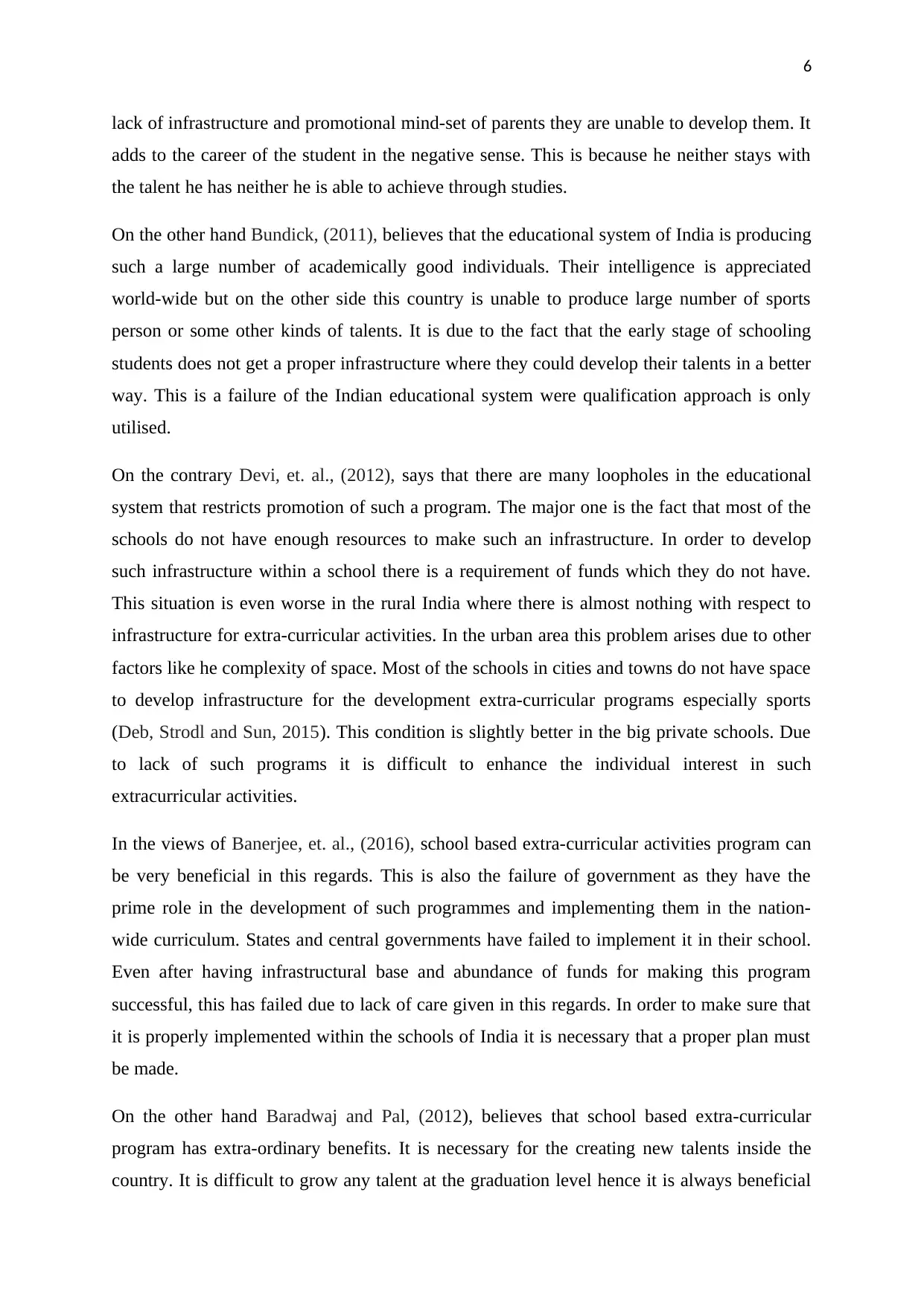
6
lack of infrastructure and promotional mind-set of parents they are unable to develop them. It
adds to the career of the student in the negative sense. This is because he neither stays with
the talent he has neither he is able to achieve through studies.
On the other hand Bundick, (2011), believes that the educational system of India is producing
such a large number of academically good individuals. Their intelligence is appreciated
world-wide but on the other side this country is unable to produce large number of sports
person or some other kinds of talents. It is due to the fact that the early stage of schooling
students does not get a proper infrastructure where they could develop their talents in a better
way. This is a failure of the Indian educational system were qualification approach is only
utilised.
On the contrary Devi, et. al., (2012), says that there are many loopholes in the educational
system that restricts promotion of such a program. The major one is the fact that most of the
schools do not have enough resources to make such an infrastructure. In order to develop
such infrastructure within a school there is a requirement of funds which they do not have.
This situation is even worse in the rural India where there is almost nothing with respect to
infrastructure for extra-curricular activities. In the urban area this problem arises due to other
factors like he complexity of space. Most of the schools in cities and towns do not have space
to develop infrastructure for the development extra-curricular programs especially sports
(Deb, Strodl and Sun, 2015). This condition is slightly better in the big private schools. Due
to lack of such programs it is difficult to enhance the individual interest in such
extracurricular activities.
In the views of Banerjee, et. al., (2016), school based extra-curricular activities program can
be very beneficial in this regards. This is also the failure of government as they have the
prime role in the development of such programmes and implementing them in the nation-
wide curriculum. States and central governments have failed to implement it in their school.
Even after having infrastructural base and abundance of funds for making this program
successful, this has failed due to lack of care given in this regards. In order to make sure that
it is properly implemented within the schools of India it is necessary that a proper plan must
be made.
On the other hand Baradwaj and Pal, (2012), believes that school based extra-curricular
program has extra-ordinary benefits. It is necessary for the creating new talents inside the
country. It is difficult to grow any talent at the graduation level hence it is always beneficial
lack of infrastructure and promotional mind-set of parents they are unable to develop them. It
adds to the career of the student in the negative sense. This is because he neither stays with
the talent he has neither he is able to achieve through studies.
On the other hand Bundick, (2011), believes that the educational system of India is producing
such a large number of academically good individuals. Their intelligence is appreciated
world-wide but on the other side this country is unable to produce large number of sports
person or some other kinds of talents. It is due to the fact that the early stage of schooling
students does not get a proper infrastructure where they could develop their talents in a better
way. This is a failure of the Indian educational system were qualification approach is only
utilised.
On the contrary Devi, et. al., (2012), says that there are many loopholes in the educational
system that restricts promotion of such a program. The major one is the fact that most of the
schools do not have enough resources to make such an infrastructure. In order to develop
such infrastructure within a school there is a requirement of funds which they do not have.
This situation is even worse in the rural India where there is almost nothing with respect to
infrastructure for extra-curricular activities. In the urban area this problem arises due to other
factors like he complexity of space. Most of the schools in cities and towns do not have space
to develop infrastructure for the development extra-curricular programs especially sports
(Deb, Strodl and Sun, 2015). This condition is slightly better in the big private schools. Due
to lack of such programs it is difficult to enhance the individual interest in such
extracurricular activities.
In the views of Banerjee, et. al., (2016), school based extra-curricular activities program can
be very beneficial in this regards. This is also the failure of government as they have the
prime role in the development of such programmes and implementing them in the nation-
wide curriculum. States and central governments have failed to implement it in their school.
Even after having infrastructural base and abundance of funds for making this program
successful, this has failed due to lack of care given in this regards. In order to make sure that
it is properly implemented within the schools of India it is necessary that a proper plan must
be made.
On the other hand Baradwaj and Pal, (2012), believes that school based extra-curricular
program has extra-ordinary benefits. It is necessary for the creating new talents inside the
country. It is difficult to grow any talent at the graduation level hence it is always beneficial
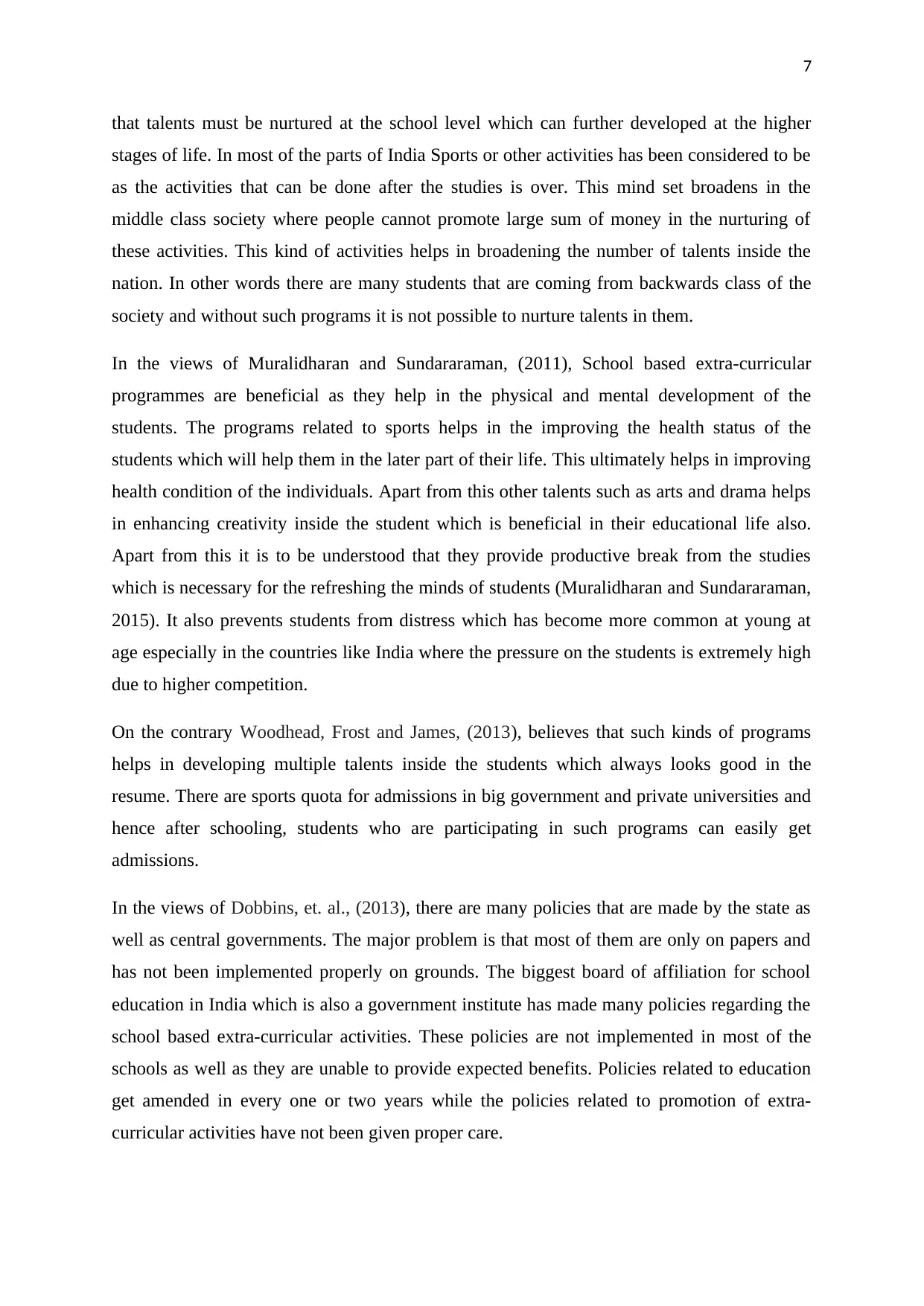
7
that talents must be nurtured at the school level which can further developed at the higher
stages of life. In most of the parts of India Sports or other activities has been considered to be
as the activities that can be done after the studies is over. This mind set broadens in the
middle class society where people cannot promote large sum of money in the nurturing of
these activities. This kind of activities helps in broadening the number of talents inside the
nation. In other words there are many students that are coming from backwards class of the
society and without such programs it is not possible to nurture talents in them.
In the views of Muralidharan and Sundararaman, (2011), School based extra-curricular
programmes are beneficial as they help in the physical and mental development of the
students. The programs related to sports helps in the improving the health status of the
students which will help them in the later part of their life. This ultimately helps in improving
health condition of the individuals. Apart from this other talents such as arts and drama helps
in enhancing creativity inside the student which is beneficial in their educational life also.
Apart from this it is to be understood that they provide productive break from the studies
which is necessary for the refreshing the minds of students (Muralidharan and Sundararaman,
2015). It also prevents students from distress which has become more common at young at
age especially in the countries like India where the pressure on the students is extremely high
due to higher competition.
On the contrary Woodhead, Frost and James, (2013), believes that such kinds of programs
helps in developing multiple talents inside the students which always looks good in the
resume. There are sports quota for admissions in big government and private universities and
hence after schooling, students who are participating in such programs can easily get
admissions.
In the views of Dobbins, et. al., (2013), there are many policies that are made by the state as
well as central governments. The major problem is that most of them are only on papers and
has not been implemented properly on grounds. The biggest board of affiliation for school
education in India which is also a government institute has made many policies regarding the
school based extra-curricular activities. These policies are not implemented in most of the
schools as well as they are unable to provide expected benefits. Policies related to education
get amended in every one or two years while the policies related to promotion of extra-
curricular activities have not been given proper care.
that talents must be nurtured at the school level which can further developed at the higher
stages of life. In most of the parts of India Sports or other activities has been considered to be
as the activities that can be done after the studies is over. This mind set broadens in the
middle class society where people cannot promote large sum of money in the nurturing of
these activities. This kind of activities helps in broadening the number of talents inside the
nation. In other words there are many students that are coming from backwards class of the
society and without such programs it is not possible to nurture talents in them.
In the views of Muralidharan and Sundararaman, (2011), School based extra-curricular
programmes are beneficial as they help in the physical and mental development of the
students. The programs related to sports helps in the improving the health status of the
students which will help them in the later part of their life. This ultimately helps in improving
health condition of the individuals. Apart from this other talents such as arts and drama helps
in enhancing creativity inside the student which is beneficial in their educational life also.
Apart from this it is to be understood that they provide productive break from the studies
which is necessary for the refreshing the minds of students (Muralidharan and Sundararaman,
2015). It also prevents students from distress which has become more common at young at
age especially in the countries like India where the pressure on the students is extremely high
due to higher competition.
On the contrary Woodhead, Frost and James, (2013), believes that such kinds of programs
helps in developing multiple talents inside the students which always looks good in the
resume. There are sports quota for admissions in big government and private universities and
hence after schooling, students who are participating in such programs can easily get
admissions.
In the views of Dobbins, et. al., (2013), there are many policies that are made by the state as
well as central governments. The major problem is that most of them are only on papers and
has not been implemented properly on grounds. The biggest board of affiliation for school
education in India which is also a government institute has made many policies regarding the
school based extra-curricular activities. These policies are not implemented in most of the
schools as well as they are unable to provide expected benefits. Policies related to education
get amended in every one or two years while the policies related to promotion of extra-
curricular activities have not been given proper care.
Paraphrase This Document
Need a fresh take? Get an instant paraphrase of this document with our AI Paraphraser
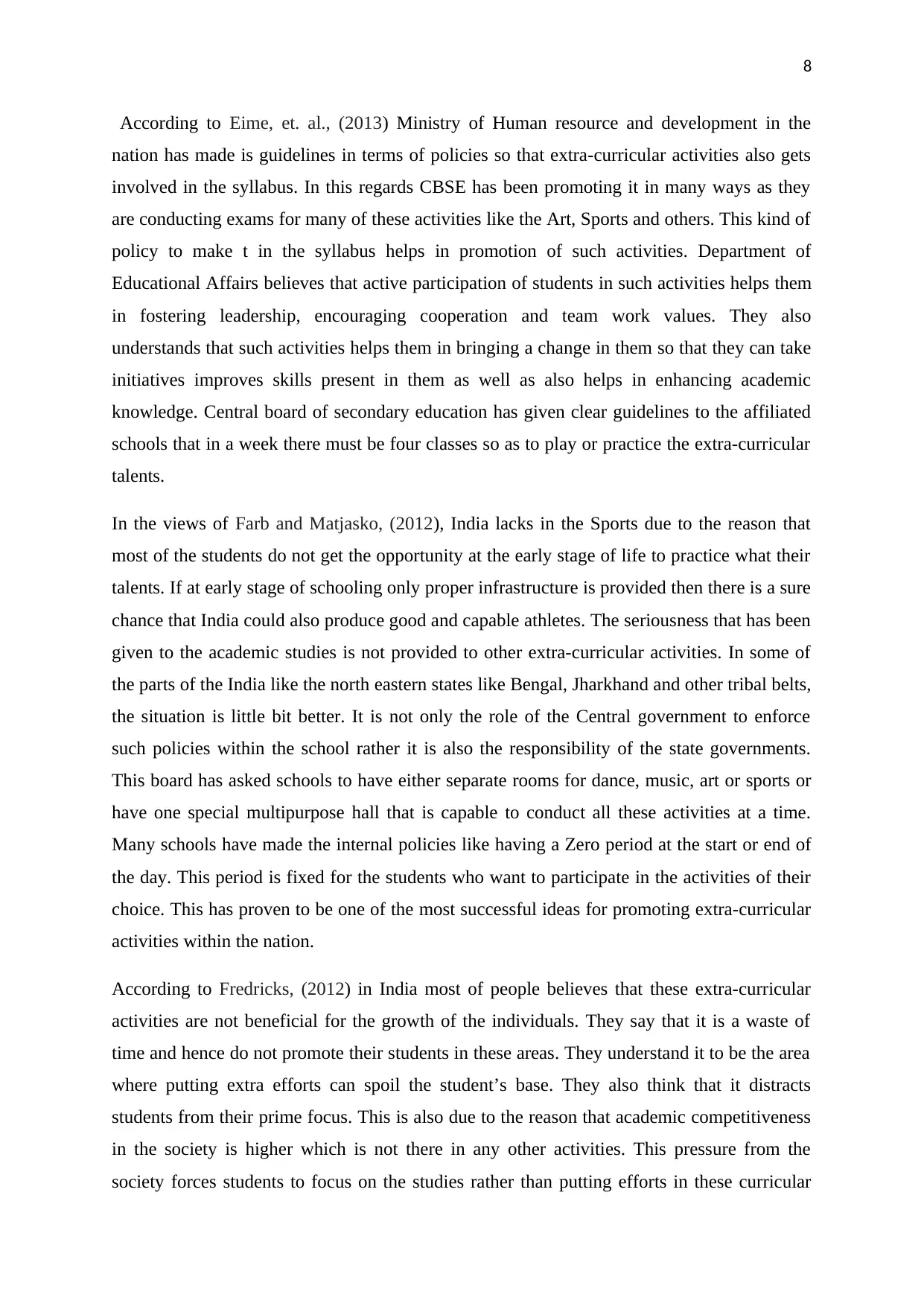
8
According to Eime, et. al., (2013) Ministry of Human resource and development in the
nation has made is guidelines in terms of policies so that extra-curricular activities also gets
involved in the syllabus. In this regards CBSE has been promoting it in many ways as they
are conducting exams for many of these activities like the Art, Sports and others. This kind of
policy to make t in the syllabus helps in promotion of such activities. Department of
Educational Affairs believes that active participation of students in such activities helps them
in fostering leadership, encouraging cooperation and team work values. They also
understands that such activities helps them in bringing a change in them so that they can take
initiatives improves skills present in them as well as also helps in enhancing academic
knowledge. Central board of secondary education has given clear guidelines to the affiliated
schools that in a week there must be four classes so as to play or practice the extra-curricular
talents.
In the views of Farb and Matjasko, (2012), India lacks in the Sports due to the reason that
most of the students do not get the opportunity at the early stage of life to practice what their
talents. If at early stage of schooling only proper infrastructure is provided then there is a sure
chance that India could also produce good and capable athletes. The seriousness that has been
given to the academic studies is not provided to other extra-curricular activities. In some of
the parts of the India like the north eastern states like Bengal, Jharkhand and other tribal belts,
the situation is little bit better. It is not only the role of the Central government to enforce
such policies within the school rather it is also the responsibility of the state governments.
This board has asked schools to have either separate rooms for dance, music, art or sports or
have one special multipurpose hall that is capable to conduct all these activities at a time.
Many schools have made the internal policies like having a Zero period at the start or end of
the day. This period is fixed for the students who want to participate in the activities of their
choice. This has proven to be one of the most successful ideas for promoting extra-curricular
activities within the nation.
According to Fredricks, (2012) in India most of people believes that these extra-curricular
activities are not beneficial for the growth of the individuals. They say that it is a waste of
time and hence do not promote their students in these areas. They understand it to be the area
where putting extra efforts can spoil the student’s base. They also think that it distracts
students from their prime focus. This is also due to the reason that academic competitiveness
in the society is higher which is not there in any other activities. This pressure from the
society forces students to focus on the studies rather than putting efforts in these curricular
According to Eime, et. al., (2013) Ministry of Human resource and development in the
nation has made is guidelines in terms of policies so that extra-curricular activities also gets
involved in the syllabus. In this regards CBSE has been promoting it in many ways as they
are conducting exams for many of these activities like the Art, Sports and others. This kind of
policy to make t in the syllabus helps in promotion of such activities. Department of
Educational Affairs believes that active participation of students in such activities helps them
in fostering leadership, encouraging cooperation and team work values. They also
understands that such activities helps them in bringing a change in them so that they can take
initiatives improves skills present in them as well as also helps in enhancing academic
knowledge. Central board of secondary education has given clear guidelines to the affiliated
schools that in a week there must be four classes so as to play or practice the extra-curricular
talents.
In the views of Farb and Matjasko, (2012), India lacks in the Sports due to the reason that
most of the students do not get the opportunity at the early stage of life to practice what their
talents. If at early stage of schooling only proper infrastructure is provided then there is a sure
chance that India could also produce good and capable athletes. The seriousness that has been
given to the academic studies is not provided to other extra-curricular activities. In some of
the parts of the India like the north eastern states like Bengal, Jharkhand and other tribal belts,
the situation is little bit better. It is not only the role of the Central government to enforce
such policies within the school rather it is also the responsibility of the state governments.
This board has asked schools to have either separate rooms for dance, music, art or sports or
have one special multipurpose hall that is capable to conduct all these activities at a time.
Many schools have made the internal policies like having a Zero period at the start or end of
the day. This period is fixed for the students who want to participate in the activities of their
choice. This has proven to be one of the most successful ideas for promoting extra-curricular
activities within the nation.
According to Fredricks, (2012) in India most of people believes that these extra-curricular
activities are not beneficial for the growth of the individuals. They say that it is a waste of
time and hence do not promote their students in these areas. They understand it to be the area
where putting extra efforts can spoil the student’s base. They also think that it distracts
students from their prime focus. This is also due to the reason that academic competitiveness
in the society is higher which is not there in any other activities. This pressure from the
society forces students to focus on the studies rather than putting efforts in these curricular
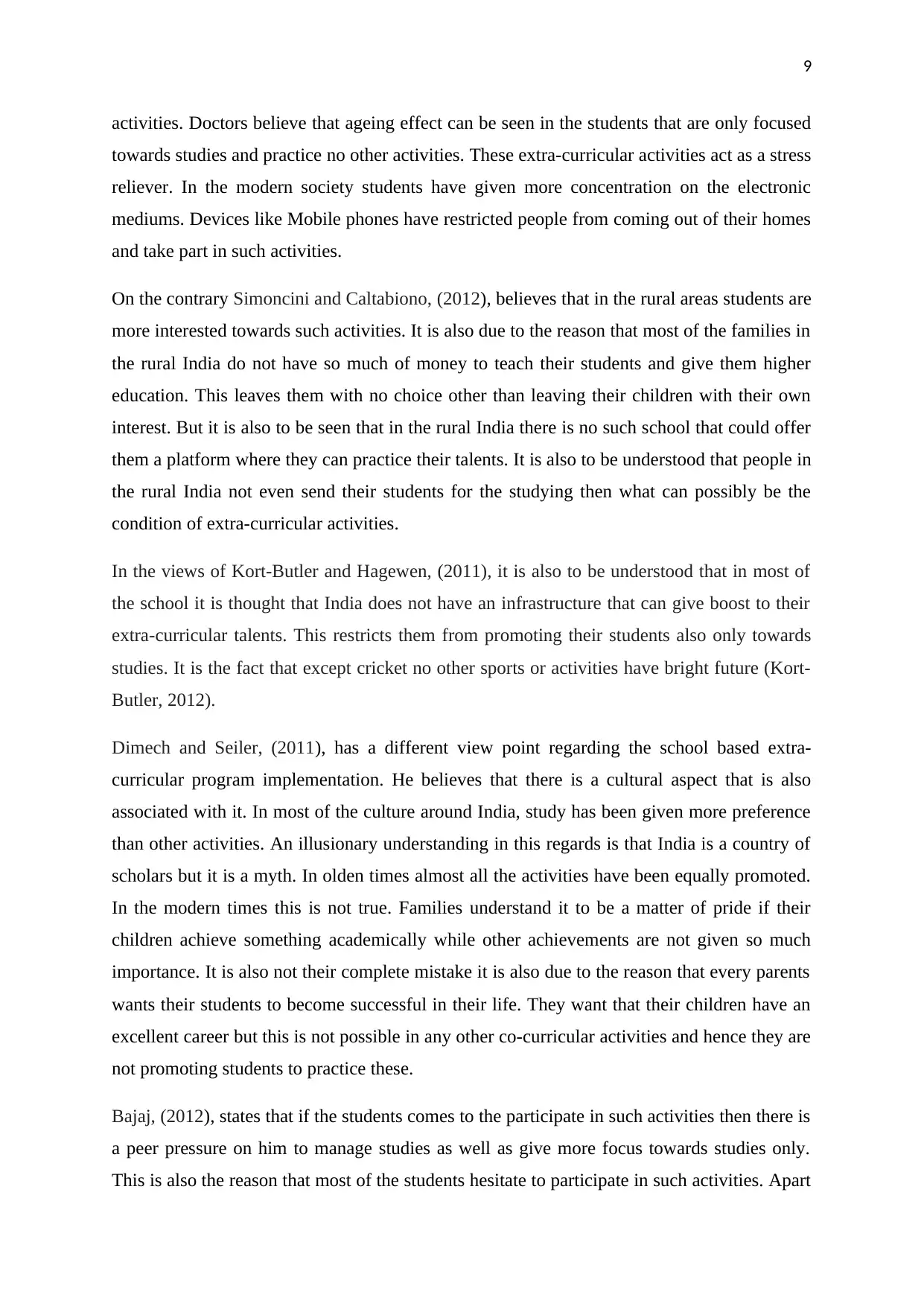
9
activities. Doctors believe that ageing effect can be seen in the students that are only focused
towards studies and practice no other activities. These extra-curricular activities act as a stress
reliever. In the modern society students have given more concentration on the electronic
mediums. Devices like Mobile phones have restricted people from coming out of their homes
and take part in such activities.
On the contrary Simoncini and Caltabiono, (2012), believes that in the rural areas students are
more interested towards such activities. It is also due to the reason that most of the families in
the rural India do not have so much of money to teach their students and give them higher
education. This leaves them with no choice other than leaving their children with their own
interest. But it is also to be seen that in the rural India there is no such school that could offer
them a platform where they can practice their talents. It is also to be understood that people in
the rural India not even send their students for the studying then what can possibly be the
condition of extra-curricular activities.
In the views of Kort-Butler and Hagewen, (2011), it is also to be understood that in most of
the school it is thought that India does not have an infrastructure that can give boost to their
extra-curricular talents. This restricts them from promoting their students also only towards
studies. It is the fact that except cricket no other sports or activities have bright future (Kort-
Butler, 2012).
Dimech and Seiler, (2011), has a different view point regarding the school based extra-
curricular program implementation. He believes that there is a cultural aspect that is also
associated with it. In most of the culture around India, study has been given more preference
than other activities. An illusionary understanding in this regards is that India is a country of
scholars but it is a myth. In olden times almost all the activities have been equally promoted.
In the modern times this is not true. Families understand it to be a matter of pride if their
children achieve something academically while other achievements are not given so much
importance. It is also not their complete mistake it is also due to the reason that every parents
wants their students to become successful in their life. They want that their children have an
excellent career but this is not possible in any other co-curricular activities and hence they are
not promoting students to practice these.
Bajaj, (2012), states that if the students comes to the participate in such activities then there is
a peer pressure on him to manage studies as well as give more focus towards studies only.
This is also the reason that most of the students hesitate to participate in such activities. Apart
activities. Doctors believe that ageing effect can be seen in the students that are only focused
towards studies and practice no other activities. These extra-curricular activities act as a stress
reliever. In the modern society students have given more concentration on the electronic
mediums. Devices like Mobile phones have restricted people from coming out of their homes
and take part in such activities.
On the contrary Simoncini and Caltabiono, (2012), believes that in the rural areas students are
more interested towards such activities. It is also due to the reason that most of the families in
the rural India do not have so much of money to teach their students and give them higher
education. This leaves them with no choice other than leaving their children with their own
interest. But it is also to be seen that in the rural India there is no such school that could offer
them a platform where they can practice their talents. It is also to be understood that people in
the rural India not even send their students for the studying then what can possibly be the
condition of extra-curricular activities.
In the views of Kort-Butler and Hagewen, (2011), it is also to be understood that in most of
the school it is thought that India does not have an infrastructure that can give boost to their
extra-curricular talents. This restricts them from promoting their students also only towards
studies. It is the fact that except cricket no other sports or activities have bright future (Kort-
Butler, 2012).
Dimech and Seiler, (2011), has a different view point regarding the school based extra-
curricular program implementation. He believes that there is a cultural aspect that is also
associated with it. In most of the culture around India, study has been given more preference
than other activities. An illusionary understanding in this regards is that India is a country of
scholars but it is a myth. In olden times almost all the activities have been equally promoted.
In the modern times this is not true. Families understand it to be a matter of pride if their
children achieve something academically while other achievements are not given so much
importance. It is also not their complete mistake it is also due to the reason that every parents
wants their students to become successful in their life. They want that their children have an
excellent career but this is not possible in any other co-curricular activities and hence they are
not promoting students to practice these.
Bajaj, (2012), states that if the students comes to the participate in such activities then there is
a peer pressure on him to manage studies as well as give more focus towards studies only.
This is also the reason that most of the students hesitate to participate in such activities. Apart
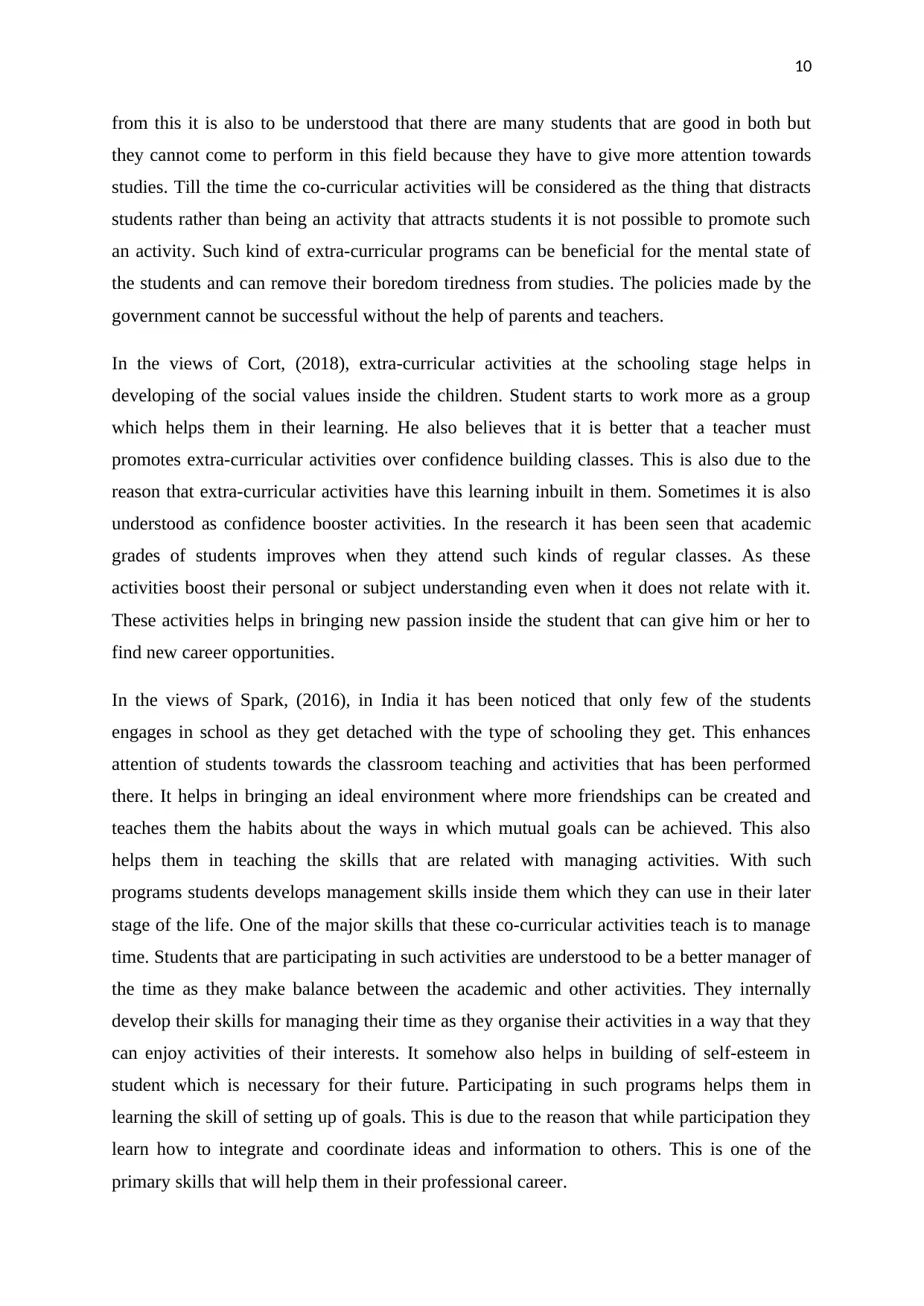
10
from this it is also to be understood that there are many students that are good in both but
they cannot come to perform in this field because they have to give more attention towards
studies. Till the time the co-curricular activities will be considered as the thing that distracts
students rather than being an activity that attracts students it is not possible to promote such
an activity. Such kind of extra-curricular programs can be beneficial for the mental state of
the students and can remove their boredom tiredness from studies. The policies made by the
government cannot be successful without the help of parents and teachers.
In the views of Cort, (2018), extra-curricular activities at the schooling stage helps in
developing of the social values inside the children. Student starts to work more as a group
which helps them in their learning. He also believes that it is better that a teacher must
promotes extra-curricular activities over confidence building classes. This is also due to the
reason that extra-curricular activities have this learning inbuilt in them. Sometimes it is also
understood as confidence booster activities. In the research it has been seen that academic
grades of students improves when they attend such kinds of regular classes. As these
activities boost their personal or subject understanding even when it does not relate with it.
These activities helps in bringing new passion inside the student that can give him or her to
find new career opportunities.
In the views of Spark, (2016), in India it has been noticed that only few of the students
engages in school as they get detached with the type of schooling they get. This enhances
attention of students towards the classroom teaching and activities that has been performed
there. It helps in bringing an ideal environment where more friendships can be created and
teaches them the habits about the ways in which mutual goals can be achieved. This also
helps them in teaching the skills that are related with managing activities. With such
programs students develops management skills inside them which they can use in their later
stage of the life. One of the major skills that these co-curricular activities teach is to manage
time. Students that are participating in such activities are understood to be a better manager of
the time as they make balance between the academic and other activities. They internally
develop their skills for managing their time as they organise their activities in a way that they
can enjoy activities of their interests. It somehow also helps in building of self-esteem in
student which is necessary for their future. Participating in such programs helps them in
learning the skill of setting up of goals. This is due to the reason that while participation they
learn how to integrate and coordinate ideas and information to others. This is one of the
primary skills that will help them in their professional career.
from this it is also to be understood that there are many students that are good in both but
they cannot come to perform in this field because they have to give more attention towards
studies. Till the time the co-curricular activities will be considered as the thing that distracts
students rather than being an activity that attracts students it is not possible to promote such
an activity. Such kind of extra-curricular programs can be beneficial for the mental state of
the students and can remove their boredom tiredness from studies. The policies made by the
government cannot be successful without the help of parents and teachers.
In the views of Cort, (2018), extra-curricular activities at the schooling stage helps in
developing of the social values inside the children. Student starts to work more as a group
which helps them in their learning. He also believes that it is better that a teacher must
promotes extra-curricular activities over confidence building classes. This is also due to the
reason that extra-curricular activities have this learning inbuilt in them. Sometimes it is also
understood as confidence booster activities. In the research it has been seen that academic
grades of students improves when they attend such kinds of regular classes. As these
activities boost their personal or subject understanding even when it does not relate with it.
These activities helps in bringing new passion inside the student that can give him or her to
find new career opportunities.
In the views of Spark, (2016), in India it has been noticed that only few of the students
engages in school as they get detached with the type of schooling they get. This enhances
attention of students towards the classroom teaching and activities that has been performed
there. It helps in bringing an ideal environment where more friendships can be created and
teaches them the habits about the ways in which mutual goals can be achieved. This also
helps them in teaching the skills that are related with managing activities. With such
programs students develops management skills inside them which they can use in their later
stage of the life. One of the major skills that these co-curricular activities teach is to manage
time. Students that are participating in such activities are understood to be a better manager of
the time as they make balance between the academic and other activities. They internally
develop their skills for managing their time as they organise their activities in a way that they
can enjoy activities of their interests. It somehow also helps in building of self-esteem in
student which is necessary for their future. Participating in such programs helps them in
learning the skill of setting up of goals. This is due to the reason that while participation they
learn how to integrate and coordinate ideas and information to others. This is one of the
primary skills that will help them in their professional career.
Secure Best Marks with AI Grader
Need help grading? Try our AI Grader for instant feedback on your assignments.
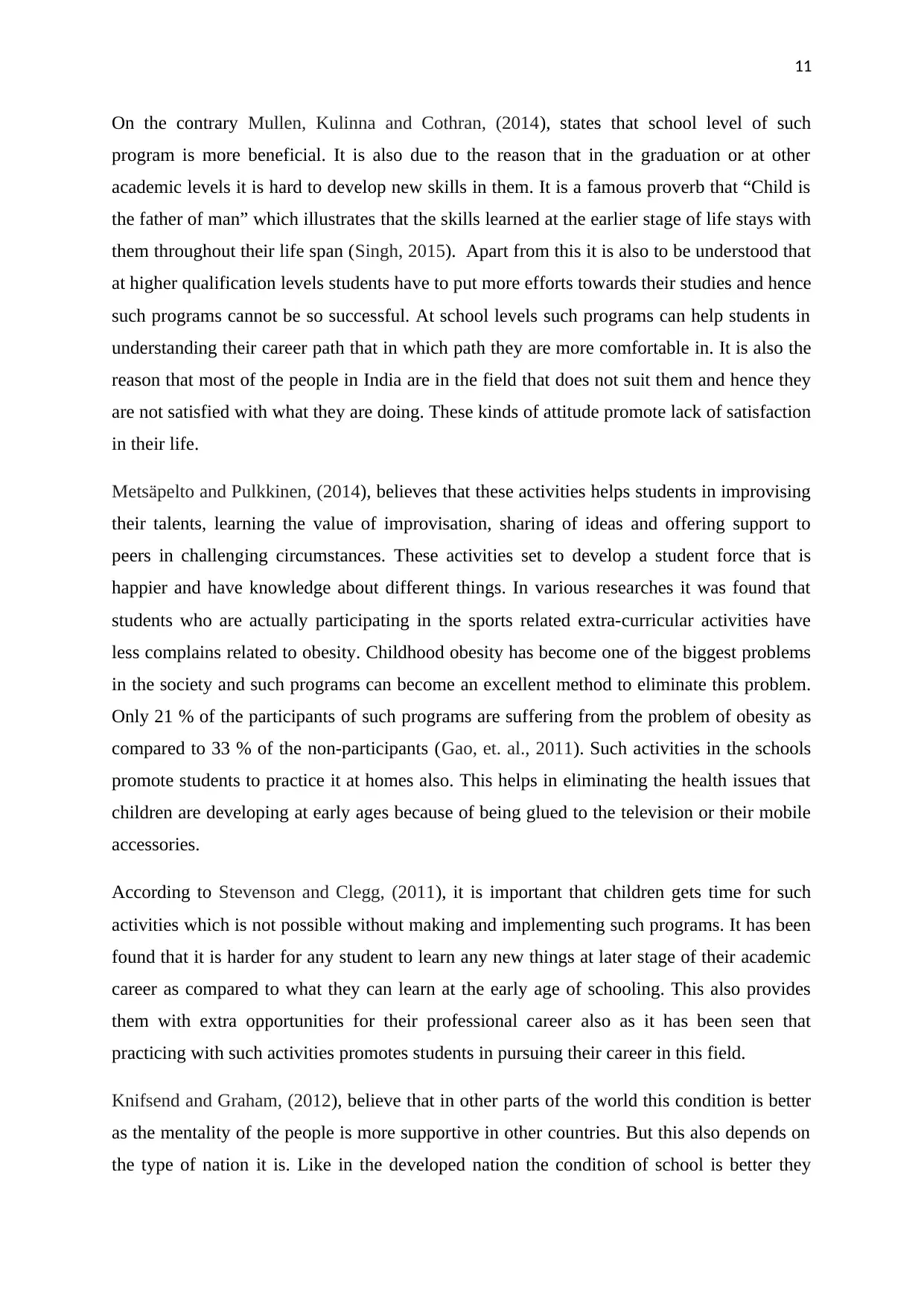
11
On the contrary Mullen, Kulinna and Cothran, (2014), states that school level of such
program is more beneficial. It is also due to the reason that in the graduation or at other
academic levels it is hard to develop new skills in them. It is a famous proverb that “Child is
the father of man” which illustrates that the skills learned at the earlier stage of life stays with
them throughout their life span (Singh, 2015). Apart from this it is also to be understood that
at higher qualification levels students have to put more efforts towards their studies and hence
such programs cannot be so successful. At school levels such programs can help students in
understanding their career path that in which path they are more comfortable in. It is also the
reason that most of the people in India are in the field that does not suit them and hence they
are not satisfied with what they are doing. These kinds of attitude promote lack of satisfaction
in their life.
Metsäpelto and Pulkkinen, (2014), believes that these activities helps students in improvising
their talents, learning the value of improvisation, sharing of ideas and offering support to
peers in challenging circumstances. These activities set to develop a student force that is
happier and have knowledge about different things. In various researches it was found that
students who are actually participating in the sports related extra-curricular activities have
less complains related to obesity. Childhood obesity has become one of the biggest problems
in the society and such programs can become an excellent method to eliminate this problem.
Only 21 % of the participants of such programs are suffering from the problem of obesity as
compared to 33 % of the non-participants (Gao, et. al., 2011). Such activities in the schools
promote students to practice it at homes also. This helps in eliminating the health issues that
children are developing at early ages because of being glued to the television or their mobile
accessories.
According to Stevenson and Clegg, (2011), it is important that children gets time for such
activities which is not possible without making and implementing such programs. It has been
found that it is harder for any student to learn any new things at later stage of their academic
career as compared to what they can learn at the early age of schooling. This also provides
them with extra opportunities for their professional career also as it has been seen that
practicing with such activities promotes students in pursuing their career in this field.
Knifsend and Graham, (2012), believe that in other parts of the world this condition is better
as the mentality of the people is more supportive in other countries. But this also depends on
the type of nation it is. Like in the developed nation the condition of school is better they
On the contrary Mullen, Kulinna and Cothran, (2014), states that school level of such
program is more beneficial. It is also due to the reason that in the graduation or at other
academic levels it is hard to develop new skills in them. It is a famous proverb that “Child is
the father of man” which illustrates that the skills learned at the earlier stage of life stays with
them throughout their life span (Singh, 2015). Apart from this it is also to be understood that
at higher qualification levels students have to put more efforts towards their studies and hence
such programs cannot be so successful. At school levels such programs can help students in
understanding their career path that in which path they are more comfortable in. It is also the
reason that most of the people in India are in the field that does not suit them and hence they
are not satisfied with what they are doing. These kinds of attitude promote lack of satisfaction
in their life.
Metsäpelto and Pulkkinen, (2014), believes that these activities helps students in improvising
their talents, learning the value of improvisation, sharing of ideas and offering support to
peers in challenging circumstances. These activities set to develop a student force that is
happier and have knowledge about different things. In various researches it was found that
students who are actually participating in the sports related extra-curricular activities have
less complains related to obesity. Childhood obesity has become one of the biggest problems
in the society and such programs can become an excellent method to eliminate this problem.
Only 21 % of the participants of such programs are suffering from the problem of obesity as
compared to 33 % of the non-participants (Gao, et. al., 2011). Such activities in the schools
promote students to practice it at homes also. This helps in eliminating the health issues that
children are developing at early ages because of being glued to the television or their mobile
accessories.
According to Stevenson and Clegg, (2011), it is important that children gets time for such
activities which is not possible without making and implementing such programs. It has been
found that it is harder for any student to learn any new things at later stage of their academic
career as compared to what they can learn at the early age of schooling. This also provides
them with extra opportunities for their professional career also as it has been seen that
practicing with such activities promotes students in pursuing their career in this field.
Knifsend and Graham, (2012), believe that in other parts of the world this condition is better
as the mentality of the people is more supportive in other countries. But this also depends on
the type of nation it is. Like in the developed nation the condition of school is better they
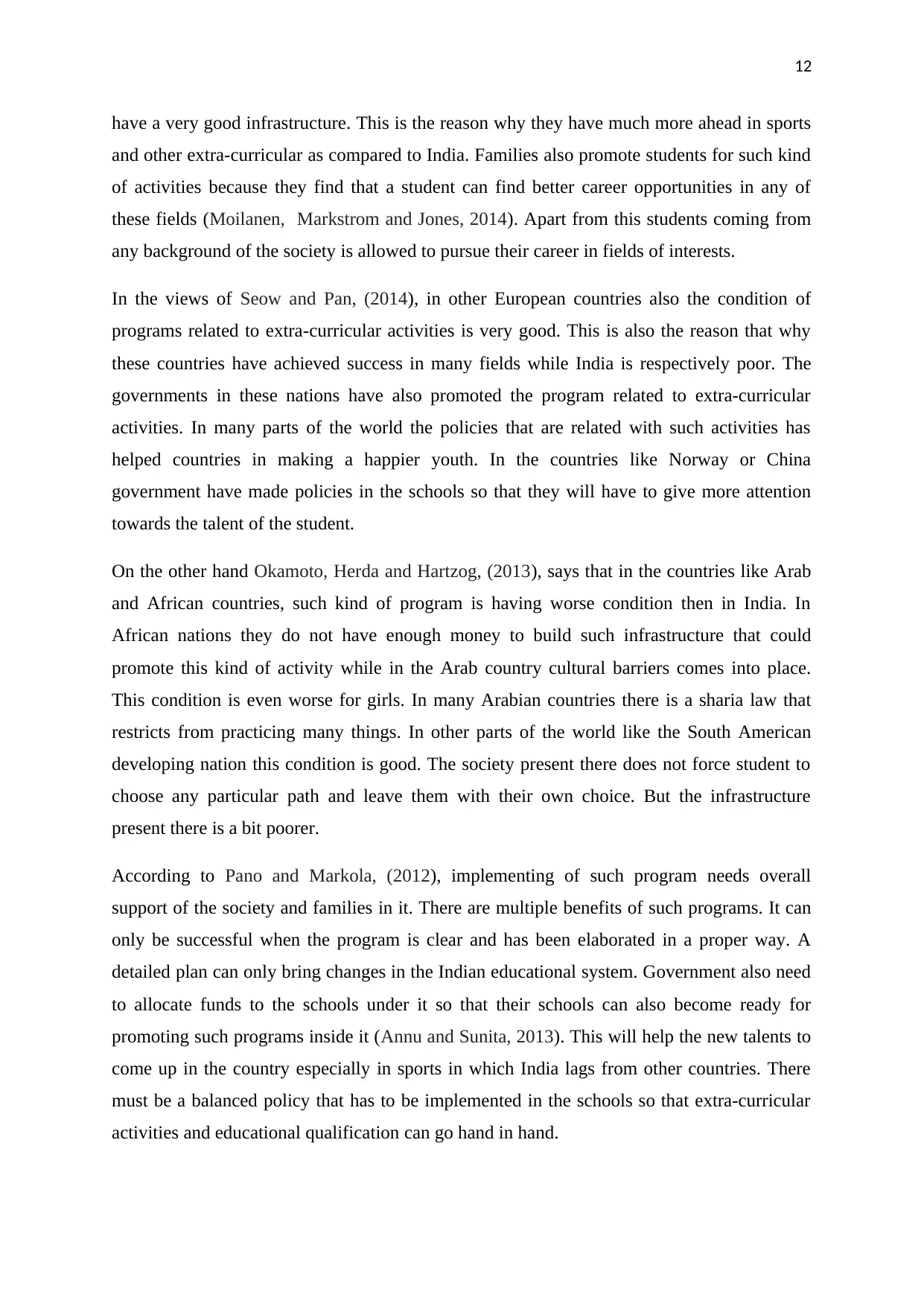
12
have a very good infrastructure. This is the reason why they have much more ahead in sports
and other extra-curricular as compared to India. Families also promote students for such kind
of activities because they find that a student can find better career opportunities in any of
these fields (Moilanen, Markstrom and Jones, 2014). Apart from this students coming from
any background of the society is allowed to pursue their career in fields of interests.
In the views of Seow and Pan, (2014), in other European countries also the condition of
programs related to extra-curricular activities is very good. This is also the reason that why
these countries have achieved success in many fields while India is respectively poor. The
governments in these nations have also promoted the program related to extra-curricular
activities. In many parts of the world the policies that are related with such activities has
helped countries in making a happier youth. In the countries like Norway or China
government have made policies in the schools so that they will have to give more attention
towards the talent of the student.
On the other hand Okamoto, Herda and Hartzog, (2013), says that in the countries like Arab
and African countries, such kind of program is having worse condition then in India. In
African nations they do not have enough money to build such infrastructure that could
promote this kind of activity while in the Arab country cultural barriers comes into place.
This condition is even worse for girls. In many Arabian countries there is a sharia law that
restricts from practicing many things. In other parts of the world like the South American
developing nation this condition is good. The society present there does not force student to
choose any particular path and leave them with their own choice. But the infrastructure
present there is a bit poorer.
According to Pano and Markola, (2012), implementing of such program needs overall
support of the society and families in it. There are multiple benefits of such programs. It can
only be successful when the program is clear and has been elaborated in a proper way. A
detailed plan can only bring changes in the Indian educational system. Government also need
to allocate funds to the schools under it so that their schools can also become ready for
promoting such programs inside it (Annu and Sunita, 2013). This will help the new talents to
come up in the country especially in sports in which India lags from other countries. There
must be a balanced policy that has to be implemented in the schools so that extra-curricular
activities and educational qualification can go hand in hand.
have a very good infrastructure. This is the reason why they have much more ahead in sports
and other extra-curricular as compared to India. Families also promote students for such kind
of activities because they find that a student can find better career opportunities in any of
these fields (Moilanen, Markstrom and Jones, 2014). Apart from this students coming from
any background of the society is allowed to pursue their career in fields of interests.
In the views of Seow and Pan, (2014), in other European countries also the condition of
programs related to extra-curricular activities is very good. This is also the reason that why
these countries have achieved success in many fields while India is respectively poor. The
governments in these nations have also promoted the program related to extra-curricular
activities. In many parts of the world the policies that are related with such activities has
helped countries in making a happier youth. In the countries like Norway or China
government have made policies in the schools so that they will have to give more attention
towards the talent of the student.
On the other hand Okamoto, Herda and Hartzog, (2013), says that in the countries like Arab
and African countries, such kind of program is having worse condition then in India. In
African nations they do not have enough money to build such infrastructure that could
promote this kind of activity while in the Arab country cultural barriers comes into place.
This condition is even worse for girls. In many Arabian countries there is a sharia law that
restricts from practicing many things. In other parts of the world like the South American
developing nation this condition is good. The society present there does not force student to
choose any particular path and leave them with their own choice. But the infrastructure
present there is a bit poorer.
According to Pano and Markola, (2012), implementing of such program needs overall
support of the society and families in it. There are multiple benefits of such programs. It can
only be successful when the program is clear and has been elaborated in a proper way. A
detailed plan can only bring changes in the Indian educational system. Government also need
to allocate funds to the schools under it so that their schools can also become ready for
promoting such programs inside it (Annu and Sunita, 2013). This will help the new talents to
come up in the country especially in sports in which India lags from other countries. There
must be a balanced policy that has to be implemented in the schools so that extra-curricular
activities and educational qualification can go hand in hand.

13
Paraphrase This Document
Need a fresh take? Get an instant paraphrase of this document with our AI Paraphraser
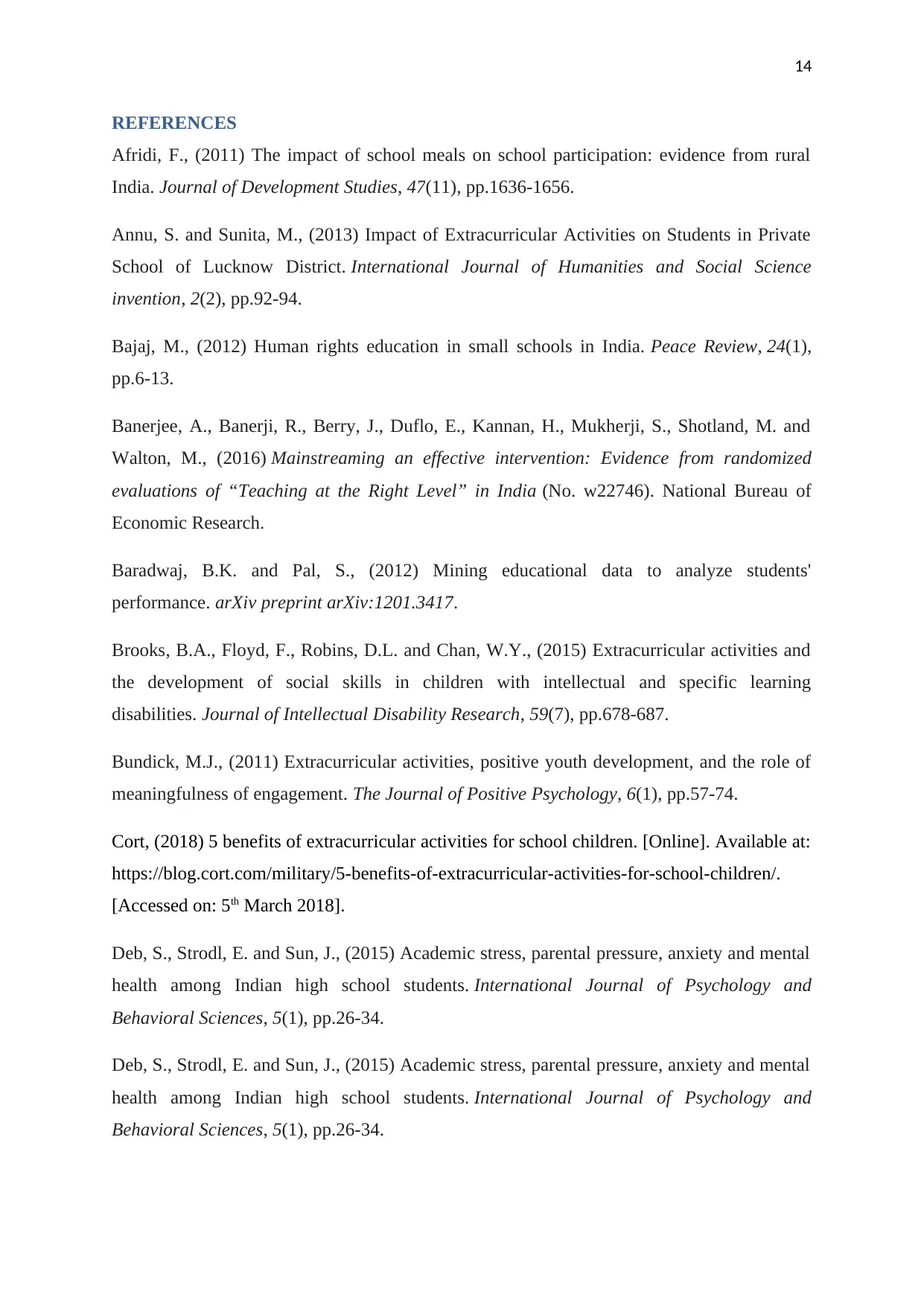
14
REFERENCES
Afridi, F., (2011) The impact of school meals on school participation: evidence from rural
India. Journal of Development Studies, 47(11), pp.1636-1656.
Annu, S. and Sunita, M., (2013) Impact of Extracurricular Activities on Students in Private
School of Lucknow District. International Journal of Humanities and Social Science
invention, 2(2), pp.92-94.
Bajaj, M., (2012) Human rights education in small schools in India. Peace Review, 24(1),
pp.6-13.
Banerjee, A., Banerji, R., Berry, J., Duflo, E., Kannan, H., Mukherji, S., Shotland, M. and
Walton, M., (2016) Mainstreaming an effective intervention: Evidence from randomized
evaluations of “Teaching at the Right Level” in India (No. w22746). National Bureau of
Economic Research.
Baradwaj, B.K. and Pal, S., (2012) Mining educational data to analyze students'
performance. arXiv preprint arXiv:1201.3417.
Brooks, B.A., Floyd, F., Robins, D.L. and Chan, W.Y., (2015) Extracurricular activities and
the development of social skills in children with intellectual and specific learning
disabilities. Journal of Intellectual Disability Research, 59(7), pp.678-687.
Bundick, M.J., (2011) Extracurricular activities, positive youth development, and the role of
meaningfulness of engagement. The Journal of Positive Psychology, 6(1), pp.57-74.
Cort, (2018) 5 benefits of extracurricular activities for school children. [Online]. Available at:
https://blog.cort.com/military/5-benefits-of-extracurricular-activities-for-school-children/.
[Accessed on: 5th March 2018].
Deb, S., Strodl, E. and Sun, J., (2015) Academic stress, parental pressure, anxiety and mental
health among Indian high school students. International Journal of Psychology and
Behavioral Sciences, 5(1), pp.26-34.
Deb, S., Strodl, E. and Sun, J., (2015) Academic stress, parental pressure, anxiety and mental
health among Indian high school students. International Journal of Psychology and
Behavioral Sciences, 5(1), pp.26-34.
REFERENCES
Afridi, F., (2011) The impact of school meals on school participation: evidence from rural
India. Journal of Development Studies, 47(11), pp.1636-1656.
Annu, S. and Sunita, M., (2013) Impact of Extracurricular Activities on Students in Private
School of Lucknow District. International Journal of Humanities and Social Science
invention, 2(2), pp.92-94.
Bajaj, M., (2012) Human rights education in small schools in India. Peace Review, 24(1),
pp.6-13.
Banerjee, A., Banerji, R., Berry, J., Duflo, E., Kannan, H., Mukherji, S., Shotland, M. and
Walton, M., (2016) Mainstreaming an effective intervention: Evidence from randomized
evaluations of “Teaching at the Right Level” in India (No. w22746). National Bureau of
Economic Research.
Baradwaj, B.K. and Pal, S., (2012) Mining educational data to analyze students'
performance. arXiv preprint arXiv:1201.3417.
Brooks, B.A., Floyd, F., Robins, D.L. and Chan, W.Y., (2015) Extracurricular activities and
the development of social skills in children with intellectual and specific learning
disabilities. Journal of Intellectual Disability Research, 59(7), pp.678-687.
Bundick, M.J., (2011) Extracurricular activities, positive youth development, and the role of
meaningfulness of engagement. The Journal of Positive Psychology, 6(1), pp.57-74.
Cort, (2018) 5 benefits of extracurricular activities for school children. [Online]. Available at:
https://blog.cort.com/military/5-benefits-of-extracurricular-activities-for-school-children/.
[Accessed on: 5th March 2018].
Deb, S., Strodl, E. and Sun, J., (2015) Academic stress, parental pressure, anxiety and mental
health among Indian high school students. International Journal of Psychology and
Behavioral Sciences, 5(1), pp.26-34.
Deb, S., Strodl, E. and Sun, J., (2015) Academic stress, parental pressure, anxiety and mental
health among Indian high school students. International Journal of Psychology and
Behavioral Sciences, 5(1), pp.26-34.
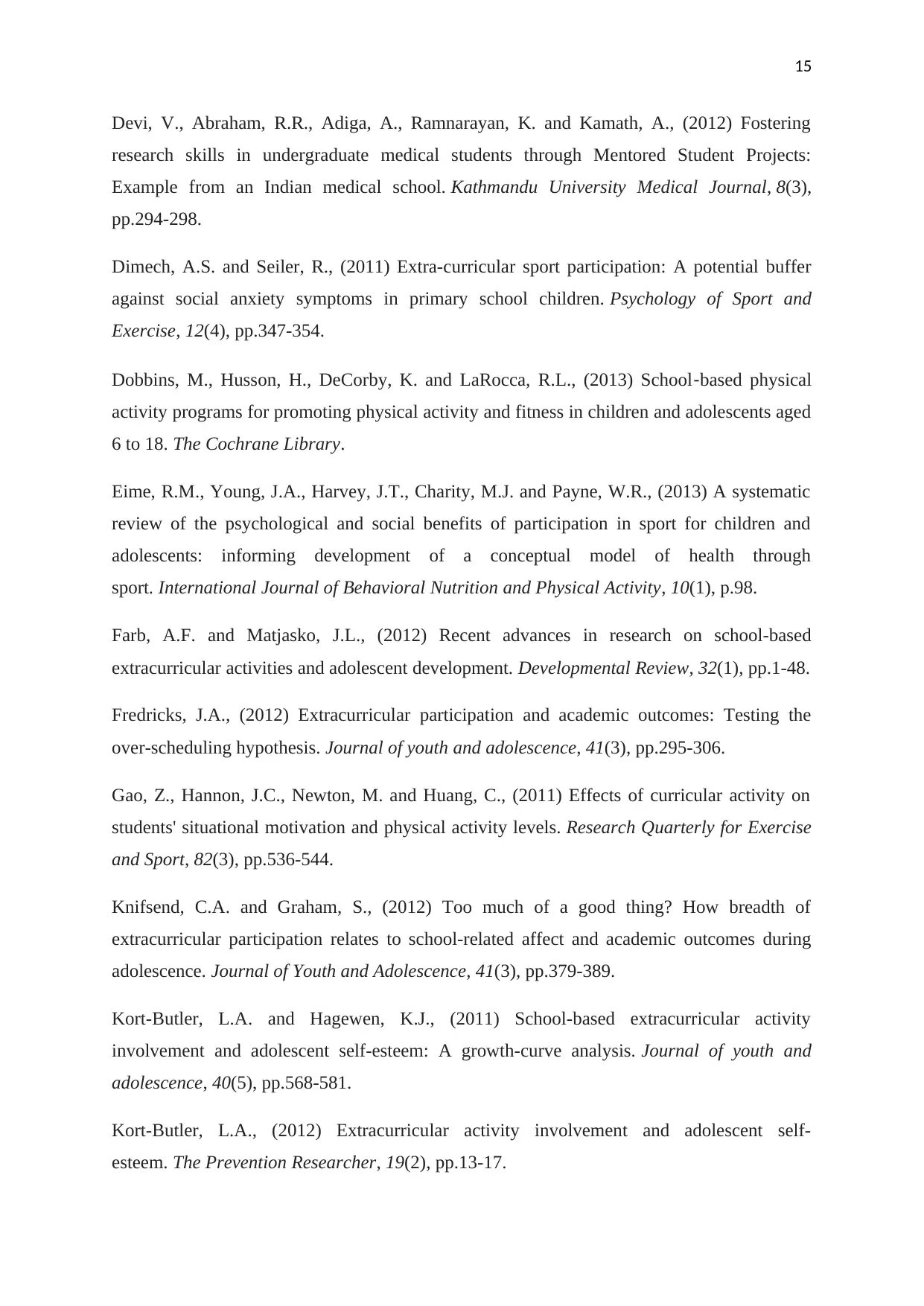
15
Devi, V., Abraham, R.R., Adiga, A., Ramnarayan, K. and Kamath, A., (2012) Fostering
research skills in undergraduate medical students through Mentored Student Projects:
Example from an Indian medical school. Kathmandu University Medical Journal, 8(3),
pp.294-298.
Dimech, A.S. and Seiler, R., (2011) Extra-curricular sport participation: A potential buffer
against social anxiety symptoms in primary school children. Psychology of Sport and
Exercise, 12(4), pp.347-354.
Dobbins, M., Husson, H., DeCorby, K. and LaRocca, R.L., (2013) School‐based physical
activity programs for promoting physical activity and fitness in children and adolescents aged
6 to 18. The Cochrane Library.
Eime, R.M., Young, J.A., Harvey, J.T., Charity, M.J. and Payne, W.R., (2013) A systematic
review of the psychological and social benefits of participation in sport for children and
adolescents: informing development of a conceptual model of health through
sport. International Journal of Behavioral Nutrition and Physical Activity, 10(1), p.98.
Farb, A.F. and Matjasko, J.L., (2012) Recent advances in research on school-based
extracurricular activities and adolescent development. Developmental Review, 32(1), pp.1-48.
Fredricks, J.A., (2012) Extracurricular participation and academic outcomes: Testing the
over-scheduling hypothesis. Journal of youth and adolescence, 41(3), pp.295-306.
Gao, Z., Hannon, J.C., Newton, M. and Huang, C., (2011) Effects of curricular activity on
students' situational motivation and physical activity levels. Research Quarterly for Exercise
and Sport, 82(3), pp.536-544.
Knifsend, C.A. and Graham, S., (2012) Too much of a good thing? How breadth of
extracurricular participation relates to school-related affect and academic outcomes during
adolescence. Journal of Youth and Adolescence, 41(3), pp.379-389.
Kort-Butler, L.A. and Hagewen, K.J., (2011) School-based extracurricular activity
involvement and adolescent self-esteem: A growth-curve analysis. Journal of youth and
adolescence, 40(5), pp.568-581.
Kort-Butler, L.A., (2012) Extracurricular activity involvement and adolescent self-
esteem. The Prevention Researcher, 19(2), pp.13-17.
Devi, V., Abraham, R.R., Adiga, A., Ramnarayan, K. and Kamath, A., (2012) Fostering
research skills in undergraduate medical students through Mentored Student Projects:
Example from an Indian medical school. Kathmandu University Medical Journal, 8(3),
pp.294-298.
Dimech, A.S. and Seiler, R., (2011) Extra-curricular sport participation: A potential buffer
against social anxiety symptoms in primary school children. Psychology of Sport and
Exercise, 12(4), pp.347-354.
Dobbins, M., Husson, H., DeCorby, K. and LaRocca, R.L., (2013) School‐based physical
activity programs for promoting physical activity and fitness in children and adolescents aged
6 to 18. The Cochrane Library.
Eime, R.M., Young, J.A., Harvey, J.T., Charity, M.J. and Payne, W.R., (2013) A systematic
review of the psychological and social benefits of participation in sport for children and
adolescents: informing development of a conceptual model of health through
sport. International Journal of Behavioral Nutrition and Physical Activity, 10(1), p.98.
Farb, A.F. and Matjasko, J.L., (2012) Recent advances in research on school-based
extracurricular activities and adolescent development. Developmental Review, 32(1), pp.1-48.
Fredricks, J.A., (2012) Extracurricular participation and academic outcomes: Testing the
over-scheduling hypothesis. Journal of youth and adolescence, 41(3), pp.295-306.
Gao, Z., Hannon, J.C., Newton, M. and Huang, C., (2011) Effects of curricular activity on
students' situational motivation and physical activity levels. Research Quarterly for Exercise
and Sport, 82(3), pp.536-544.
Knifsend, C.A. and Graham, S., (2012) Too much of a good thing? How breadth of
extracurricular participation relates to school-related affect and academic outcomes during
adolescence. Journal of Youth and Adolescence, 41(3), pp.379-389.
Kort-Butler, L.A. and Hagewen, K.J., (2011) School-based extracurricular activity
involvement and adolescent self-esteem: A growth-curve analysis. Journal of youth and
adolescence, 40(5), pp.568-581.
Kort-Butler, L.A., (2012) Extracurricular activity involvement and adolescent self-
esteem. The Prevention Researcher, 19(2), pp.13-17.
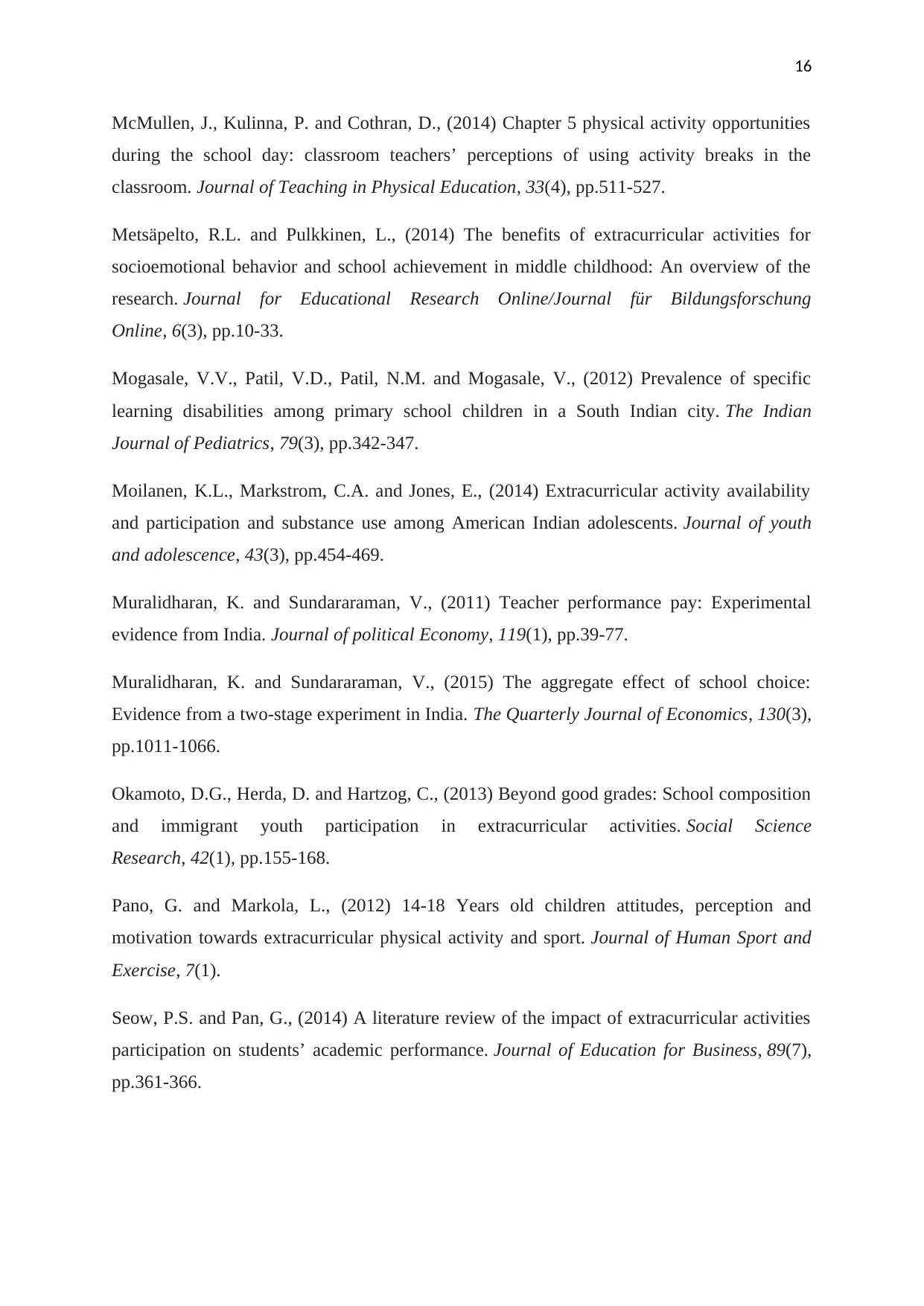
16
McMullen, J., Kulinna, P. and Cothran, D., (2014) Chapter 5 physical activity opportunities
during the school day: classroom teachers’ perceptions of using activity breaks in the
classroom. Journal of Teaching in Physical Education, 33(4), pp.511-527.
Metsäpelto, R.L. and Pulkkinen, L., (2014) The benefits of extracurricular activities for
socioemotional behavior and school achievement in middle childhood: An overview of the
research. Journal for Educational Research Online/Journal für Bildungsforschung
Online, 6(3), pp.10-33.
Mogasale, V.V., Patil, V.D., Patil, N.M. and Mogasale, V., (2012) Prevalence of specific
learning disabilities among primary school children in a South Indian city. The Indian
Journal of Pediatrics, 79(3), pp.342-347.
Moilanen, K.L., Markstrom, C.A. and Jones, E., (2014) Extracurricular activity availability
and participation and substance use among American Indian adolescents. Journal of youth
and adolescence, 43(3), pp.454-469.
Muralidharan, K. and Sundararaman, V., (2011) Teacher performance pay: Experimental
evidence from India. Journal of political Economy, 119(1), pp.39-77.
Muralidharan, K. and Sundararaman, V., (2015) The aggregate effect of school choice:
Evidence from a two-stage experiment in India. The Quarterly Journal of Economics, 130(3),
pp.1011-1066.
Okamoto, D.G., Herda, D. and Hartzog, C., (2013) Beyond good grades: School composition
and immigrant youth participation in extracurricular activities. Social Science
Research, 42(1), pp.155-168.
Pano, G. and Markola, L., (2012) 14-18 Years old children attitudes, perception and
motivation towards extracurricular physical activity and sport. Journal of Human Sport and
Exercise, 7(1).
Seow, P.S. and Pan, G., (2014) A literature review of the impact of extracurricular activities
participation on students’ academic performance. Journal of Education for Business, 89(7),
pp.361-366.
McMullen, J., Kulinna, P. and Cothran, D., (2014) Chapter 5 physical activity opportunities
during the school day: classroom teachers’ perceptions of using activity breaks in the
classroom. Journal of Teaching in Physical Education, 33(4), pp.511-527.
Metsäpelto, R.L. and Pulkkinen, L., (2014) The benefits of extracurricular activities for
socioemotional behavior and school achievement in middle childhood: An overview of the
research. Journal for Educational Research Online/Journal für Bildungsforschung
Online, 6(3), pp.10-33.
Mogasale, V.V., Patil, V.D., Patil, N.M. and Mogasale, V., (2012) Prevalence of specific
learning disabilities among primary school children in a South Indian city. The Indian
Journal of Pediatrics, 79(3), pp.342-347.
Moilanen, K.L., Markstrom, C.A. and Jones, E., (2014) Extracurricular activity availability
and participation and substance use among American Indian adolescents. Journal of youth
and adolescence, 43(3), pp.454-469.
Muralidharan, K. and Sundararaman, V., (2011) Teacher performance pay: Experimental
evidence from India. Journal of political Economy, 119(1), pp.39-77.
Muralidharan, K. and Sundararaman, V., (2015) The aggregate effect of school choice:
Evidence from a two-stage experiment in India. The Quarterly Journal of Economics, 130(3),
pp.1011-1066.
Okamoto, D.G., Herda, D. and Hartzog, C., (2013) Beyond good grades: School composition
and immigrant youth participation in extracurricular activities. Social Science
Research, 42(1), pp.155-168.
Pano, G. and Markola, L., (2012) 14-18 Years old children attitudes, perception and
motivation towards extracurricular physical activity and sport. Journal of Human Sport and
Exercise, 7(1).
Seow, P.S. and Pan, G., (2014) A literature review of the impact of extracurricular activities
participation on students’ academic performance. Journal of Education for Business, 89(7),
pp.361-366.
Secure Best Marks with AI Grader
Need help grading? Try our AI Grader for instant feedback on your assignments.
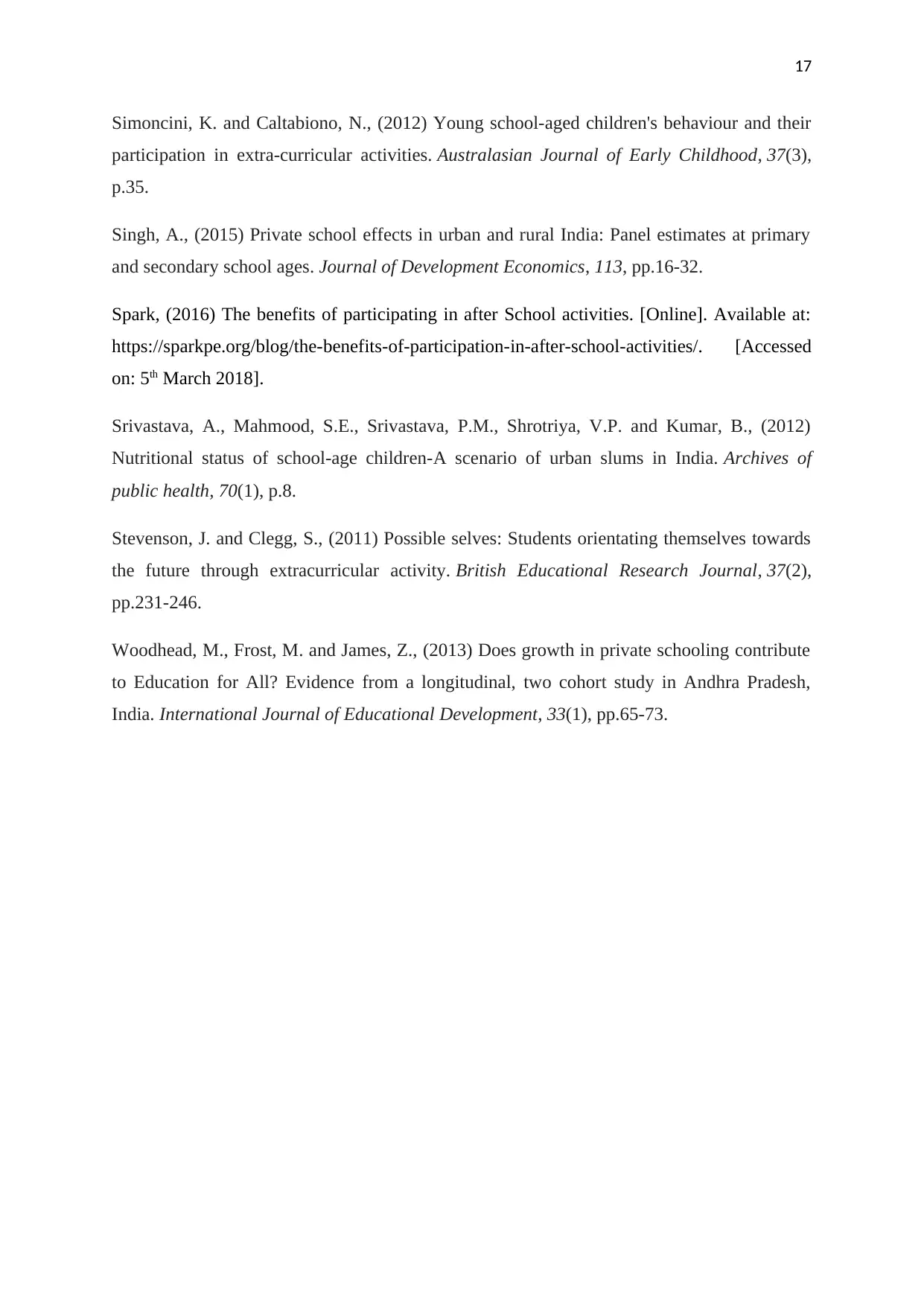
17
Simoncini, K. and Caltabiono, N., (2012) Young school-aged children's behaviour and their
participation in extra-curricular activities. Australasian Journal of Early Childhood, 37(3),
p.35.
Singh, A., (2015) Private school effects in urban and rural India: Panel estimates at primary
and secondary school ages. Journal of Development Economics, 113, pp.16-32.
Spark, (2016) The benefits of participating in after School activities. [Online]. Available at:
https://sparkpe.org/blog/the-benefits-of-participation-in-after-school-activities/. [Accessed
on: 5th March 2018].
Srivastava, A., Mahmood, S.E., Srivastava, P.M., Shrotriya, V.P. and Kumar, B., (2012)
Nutritional status of school-age children-A scenario of urban slums in India. Archives of
public health, 70(1), p.8.
Stevenson, J. and Clegg, S., (2011) Possible selves: Students orientating themselves towards
the future through extracurricular activity. British Educational Research Journal, 37(2),
pp.231-246.
Woodhead, M., Frost, M. and James, Z., (2013) Does growth in private schooling contribute
to Education for All? Evidence from a longitudinal, two cohort study in Andhra Pradesh,
India. International Journal of Educational Development, 33(1), pp.65-73.
Simoncini, K. and Caltabiono, N., (2012) Young school-aged children's behaviour and their
participation in extra-curricular activities. Australasian Journal of Early Childhood, 37(3),
p.35.
Singh, A., (2015) Private school effects in urban and rural India: Panel estimates at primary
and secondary school ages. Journal of Development Economics, 113, pp.16-32.
Spark, (2016) The benefits of participating in after School activities. [Online]. Available at:
https://sparkpe.org/blog/the-benefits-of-participation-in-after-school-activities/. [Accessed
on: 5th March 2018].
Srivastava, A., Mahmood, S.E., Srivastava, P.M., Shrotriya, V.P. and Kumar, B., (2012)
Nutritional status of school-age children-A scenario of urban slums in India. Archives of
public health, 70(1), p.8.
Stevenson, J. and Clegg, S., (2011) Possible selves: Students orientating themselves towards
the future through extracurricular activity. British Educational Research Journal, 37(2),
pp.231-246.
Woodhead, M., Frost, M. and James, Z., (2013) Does growth in private schooling contribute
to Education for All? Evidence from a longitudinal, two cohort study in Andhra Pradesh,
India. International Journal of Educational Development, 33(1), pp.65-73.

18
1 out of 18
Your All-in-One AI-Powered Toolkit for Academic Success.
+13062052269
info@desklib.com
Available 24*7 on WhatsApp / Email
![[object Object]](/_next/static/media/star-bottom.7253800d.svg)
Unlock your academic potential
© 2024 | Zucol Services PVT LTD | All rights reserved.
